




FULLY SPECCED WITH HIGH-TECH EQUIPMENT FOR ALL YOUR ADVENTURES... NO MATTER WHERE IN THE WORLD! WITH 15,000KM SERVICE
MORE POWER - 150HP (110kw)
LONG SERVICE INTERVALS - 15,000kms
FULL ELECTRONICS ASSISTANCE PACKAGES (MSC, ABS AND MTC) AS STANDARD - SAVE THOUSANDS!
MOTORCYCLE STABILITY CONTROL - MSC gives the rider a lean-sensitive traction control
MANAGED TRACTION CONTROL - MTC allows Sport, Street, Rain and Off-road modes
BOSCH 9ME C-ABS - Combined Anti-Lock Braking System
BREMBO BRAKES - Precise application, powerful and free from fading
MULTI-FUNCTION COCKPIT - State-of-the-art instrument cluster with adjustable features
MODE SWITCH - Simple and intuitive to use
ADJUSTABLE ERGONOMICS - to suit individuals

» Two handlebar clamping positions: horizontal +/- 10 mm
» Two rider seat heights 860 mm + 15 mm
» Two footrest positions: diagonal 10 mm high and back
ADJUSTABLE WINDSHIELD - To suit varied sizes of rider
WP STEERING DAMPER - Makes for a smooth ride
LED INDICATORS Brighter and better


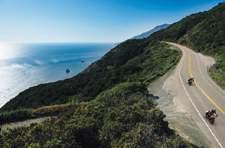


Tom Foster - Editor
I’m riding a lot slower these days. People who know me well will be rolling around on the floor laughing when they read that. All my life I’ve always been the slowest rider in any group I’ve been part of, and to say I’m going slower now will hardly seem possible. You think I’m joking?
I remember
v My first Finke Desert Race. When I rolled into the fuel stop the crew had packed up and were having a quiet beer. I’d taken so long to get there they’d assumed I’d crashed out;
v A Thumper Nats where the mechanic went missing during the race. He later said I was riding so slow he wanted to throw rocks at me, got bored and wandered back to the pit; and
“He later said I was riding so slow he wanted to throw rocks at me.”
v Riding a National championship at Eastern Creek and my son telling me when he saw me tipping in to Turn 12 he knew he had time to go grab a coffee and wander back to wave me over the start/finish line.
I’ve never been fast. I always wanted to be, but I never was.
Lately I find I’m riding slower than ever, but the interesting thing about that is I’m not caring too much about the lack of speed. I still love the thrill of competition, and I still get a rush when I slide open the shed door and see my 125 motocrosser and my little bucket road-racer sitting there, stinging to cut fast times. I still fire up when I climb on those bikes and ask them to do what they were built to do.
But the bike that gets used most now is the adventure bike. It’s big, soft and

comfortable, and it’s very low on horsepower. But there’s a very special kind of fulfillment that comes from getting to places most people dream of and never see. Marvelling at the snow in the mountains of Europe, dashing down a beach for a swim in the Mediterranean, gasping for breath in the Andes, watching the sunrise over the Mekong or gazing over the cliffs of the Great Australian Bight…those are deeply moving moments equal to any trophy or any lap time. You don’t have to be fast, talented or even clever to reach those goals. All you have to do is have the heart to climb on your bike and go. In fact, riding fast works against you. Savouring the amazing, unique, neverto-be-repeated sensation of being in that place at that moment takes time. You get far more from the experience by taking it slowly and seeing, hearing and feeling
all that’s going on, and making sure you have that page solidly written in your book of life.
It took me a long time to learn just how important ‘unique’ is, and to understand how I’ve been gifted with amazing opportunities to dive head-first into heart-stopping, amazing places and situations. I’m finally discovering the self-discipline needed to immerse myself in those experiences and soak them up instead of powering through them and fretting about what the stopwatch will show.
Adventure riding’s about the ride and getting there. When you do get there it’s about enjoying having achieved something awesome and amazing. The ride is every bit as important as the destination, and I’m living every moment on the bike.
Yes sir. The slower I go now, the better things get.


Adventure Rider Magazine is published bi-monthly by Mayne Publications Pty Ltd
Publisher Kurt M Quambusch
Editor Tom Foster tom@advridermag.com.au
Sales Director
Marcus Hucker
Advertising Sales Hayden Jarvis hayden@trademags.com.au 02 9452 4517
Production Manager Michelle Alder michelle@trademags.com.au
Melissa Perreault production@trademags.com.au
Design Danny Bourke art@trademags.com.au
Accounts Jeewan Gnawali jeewan@trademags.com.au
ISSN 2201-1218
ACN 130 678 812
ABN 27 130 678 812
Postal address: PO Box 489, DEE WHY NSW 2099 Australia
Website: www.advridermag.com.au
Enquiries:
Phone: 1300 76 4688
Int.ph: +612 9452 4517
Int.fax: +612 9452 5319











A 44-year-old, Tasmanian police officer, Andrew rides a 2010 BMW R1200 GSA. Andrew spends a lot of time riding dirt bikes and quads with his daughters, and only recently started riding with the Tas Adv Riders Hub.

John bought his first bike back in 1969 and hasn’t been without one since – always dirt bikes. He raced enduros, and started adventure riding before the word ‘adventure’ was really embraced. He’s a past president, and the current webmaster, of the Ulysses Adventure Riders.

Karen’s in that growing group of females either returning to riding or taking it up. She’s worked in the Northern Territory as a governess/jillaroo, supervising kids and mustering on ’bikes, and bought her first bike from an undertaker.

A lifelong rider, Robin now rides, “whenever there’s a chance” on any bike available, on- or off-road. Between churning out Safari Tanks and importing high-quality Touratech gear, there’s not as much riding going on for this Victorian-based bloke as he’d like.

Miles has been National Motorrad Marketing Manager for BMW Motorrad since 2006. He’s a highly qualified motorcycling coach and an ex-professional mountain-bike racer. Still on a bike every chance he gets, Miles has built an enviable reputation as both a worldclass rider and a great riding companion.

Barb is more at home on the back of a horse than a bike, but she’s followed the love of her life, Mark, to new adventures on the back of motorcycles. Both retired science teachers, they are travelling the dream – everywhere and everything.

John thought adventure riders would love an event offering some of the thrill and challenge of The Dakar at a miniscule price, so in 2010 the real estate manager kicked off the APC Rally.

Ken’s children and grandchildren keep trying to tell him he’s old and should slow down. There’s never been a time where there wasn’t a bike in the shed and he now uses the riding as a motivator to simply keep fit.

Craig has been riding for 40 years and has competed in enduros in Australia, New Zealand and New Caledonia. The purchase of Dalby Moto in 1984 was to feed his dirt-bike habit. Adventure riding came on the scene in 1995 and he’s ridden three Safaris and manages the largest trail-ride series in the world. In his spare time Craig still rides trail, adventure and road.







The third running of the 7000km, 14-day, non-competitive adventure rally had it all: superb weather, roads and trails in excellent condition and a challenge here and there to keep all 80 or so riders on their toes. Ken Dark zig-zagged his 1190 over the course to keep track of things.
Those that followed our coverage of this epic event may remember the theme in 2013 was wet: wet and muddy, wet and slippery, wet and slow and just plain wet for days on end. The weather gods this year must’ve been in a good mood because the Rally was mostly dry. Indeed, when we passed through the Snowy Mountains in NSW it was just dusty. There were a few damp patches, just enough to keep everyone honest, but nothing to get excited about.
As the Wodonga finishers went through some days later, it was a shocker of a slush-fest and a challenge for even very experienced riders.
That’s the luck of the draw on a ride as big as this one.
Plans are made to be broken, right? Looping around, interviewing and


photographing entrants seemed like a good idea. It was too, until I got sucked into joining the event ‘for just a section or two’. Four days later I was still in the thick of it with a crew of Sydney entrants.
After the fun of the Snowys and the Hattah sand it was time to head back to reality. Kurt, my riding buddy, and I hotfooted it back to the start to try and catch the next group coming through. This is a big country. It took a day-and-a-half just to ride across a small sample of this wide, brown land.
Enough waffle. What about the event?
With 81 riders spread out from the Flinders Ranges in South Australia to the Snowy
u





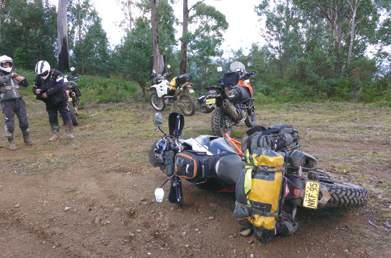
Mountains of NSW, Cameron Corner in Queensland and the Hattah Desert in north-western Victoria, it’s almost impossible to talk to all entrants, but I suspect those I did catch up with are pretty representative of the field.
Apparently it’s not an event to attract the young in years, just the young at heart. The average age of entrants is a youthful 47. The oldest of those I spoke to was 63, while the baby of the field was only 30. There were several riders well into their 60s. Can you believe it? When you realise that, there’s no room for excuses. Get out there!
And c’mon, ladies. The fairer sex was totally unrepresented this year. Some of you need to take up the challenge and show the blokes how it’s done.
Occupations of riders included farmers, engineers, miners, plumbers, technical officers, project managers, IT managers, production managers, a stock market guru, a postman and a scientist. Obviously background is of no consequence, all that’s needed is an adventurous spirit, some bike skills and passion.
Bike choice is a very personal thing. Reasons for preferences varied from, “It’s the only bike I have,” to, “Electric-start and bulletproof, plus I have a broken foot so can’t kickstart my XR600 anymore.” There was also, “I bought a DR650 because it’s the Clydesdale of the industry,” and just about everything in between. It didn’t really matter what bike you were aboard as long as you were comfortable with your choice.
Among starters there were 33 KTMs, 20 Suzukis, 10 Hondas, 10 Yamahas, five Kawasakis, three Triumphs, and a couple of Huskies.
Probably the most interesting outcome of my questioning was the response to, “Why ride the APC Rally?”
Almost everyone came up with similar themes: “Two-wheel therapy.” “Get your alone time.” “Freedom,” and, “Relaxation.”
1: Hopper was a legend. Always smiling, and always finishing every day.
2: Starters at Wiseman’s Ferry.
3: Hoppers bike.
4: Omeo at last!
5: Just resting.
Below: Jenolan Caves offered a novel experience – riding through the cave tunnel.

Sure there were a few, “It’s my passion,” responses, but the meditation theme came through very strongly. As we all know, there’s no opportunity to think of anything else but the trail immediately ahead when you’re riding off-road – or the consequences could be nasty! The challenge of staying focused for 14 days is just great mental therapy.
Comments like, “It’s the ultimate challenge!” were common. There were

also several responses along the lines of having been conned into the ride by a mate, and quite a few likened it to the Dakar, but with an affordable price tag. Lots wanted to test themselves and their machines to see if they had what it takes to back up day-after-day to get the job done as well as just touring the countryside and visiting out-of-the-way places.
The group I met at the Moonan Flat pub were all starters from Wodonga in Victoria. Apart from two brothers, the blokes didn’t know each other before the ride started. By the time I met them they were a well-bonded social group who enjoyed each other’s company and who needed reminding the next day’s riding was more important than another bottle of wine. This was fairly typical of the comradeship engendered by the event. The APC theme of ‘look after your riding mate’ forged close relationships.
When asked how long various riders expected to take to complete the course, most responses were, “We’re hoping for 14 days.” There were a few allowing 15 days or more, and a couple said they didn’t care how long it took, they were just out to have a good time.
Here comes the sand. u
It needs to be said that the event is definitely not a race. How long it takes is up to each individual. Most of us forget to smell the roses in life, and this event is no different. You can complete the event in 14 days (or less if you’re dedicated and have no problems), but to enjoy the scenery and variety of country on display could be a lot more satisfying than being the first home.






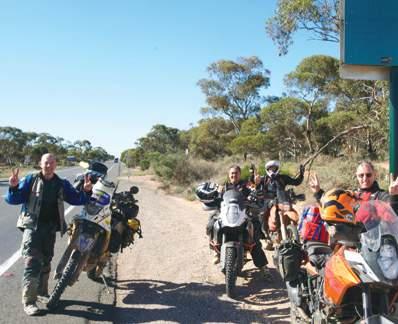
There were plenty of individuals of distinction I just didn’t get to meet, but of the riders whose path I crossed there were a few who particularly stood out.
First cab off the rank was Hopper. By his own admission Hopper’s not a gun rider. In fact he reckons he’s not even a pistol. Speedy he may not be, but he’s bloody determined. He and his rallyekitted WR450F just keep on keeping on. He doesn’t stop for much, and his meals were mostly three courses: a Mars Bar for entrée, a Mars Bar main and another Mars Bar for dessert. We’d all be at the pub having washed down the day’s dust, had a shower and often eaten when we’d hear the WR put-put into town. The typical greeting was “Bloody Hopper! You’re a machine!”
We were all nice and dry in the pub at Mount Beauty in the Snowy Mountains when Mother Nature decided to break the drought. It pissed down half the night. That was the night Hopper decided to get ahead of us by camping out (at 1200m elevation). The tent held up pretty well until the early hours when he thought he’d regained his youth, wet bed and all.
It just goes to show you don’t need to ride fast, just be consistent and bloody stubborn.
Steve from WA was another youthful bloke, celebrating his 59th birthday on the second day of the Rally.
“In 2011 I had a health scare which resulted in a new hip,” grinned Steve, “so now I just do the things I enjoy.”
He likes to do iconic events and has competed in three Australian Safaris. Steve’s goal is to just “go out and meet a bunch of guys and have a good time.”
Steve rode his KTM1190 from Perth to the Wodonga start, and after the finish was planning to ride the Great Ocean Road with a mate, then pop up to Finke for a bit of a look before riding home.
Steve reckons the APC is great training for anyone contemplating the Australian Safari.
Finally, Craig Hartley would stand out in pretty much any crowd.
He decided two days before the event that he “might give it a go”. He jumped aboard his KTM700RR and hooked in, aiming to ride as consistently as he could for as many hours of the day as possible, camping most of the way. This technique was certainly time-efficient. He’d pull up whenever he’d had enough, no matter where he was. Craig certainly didn’t stop to smell the roses. In fact I don’t think he stopped to eat. He completed the entire
event – no shortcuts – in just over nine days. Although I do think he cheated by managing one night in his own bed as he passed through Dalby, Queensland. I really don’t think that’s in the rules Craig, even if you had to put in a 1200km day to do it.
Standing alongside Craig Hartley was Ken Allen. Ken cracked his kneecap when he dropped his bike over a slippery causeway outside Singleton. He rode the rest of the event like that. What a tough old bastard!
Pete from Cessnock must have the most tolerant wife on the planet. On a recent ride Pete had a breakdown about four hours from his home. No problem. Just ring The Little Lady and have her bring the trailer down for the recovery. A small discussion with an emu in the Hattah saw him literally knocked out of the event. He had a broken bike and broken head. No problem for Pete,

1: Stuck.
2: Plenty of winding roads to enjoy.
3: Service time.
4: Yeehah! We conquered the Hattah! Main: Things got a little sandy in places.
though. He once again phoned home and the recovery vehicle was on its way. No big deal, really. It’s only a 2600km round trip from Cessnock to Renmark with a trailer in tow. Where do you find a woman like that?
Wildlife
You think ’roos are stupid? They’re brainiacs compared to emus.
After an emu runs across the front of your bike it’ll often just turn 180 degrees on the spot and run back to and give you another go. One entrant reported 69 live ’roos in 80km just out of Thargominda. That’s another reason APC guidelines suggest stopping by 5:00pm.
Location, location, location
A couple of riders stopped for a chat when I was taking photos from a mountaintop near Singleton. One of the bikes had a rear end that was behaving a bit like a 1953 VW with stock shocks. We managed to make a few
phone calls and had him hooked up with a local suspension expert. The story ended well with the bike being back in action a couple of hours later.
It wasn’t until I went to make another phone call I realised I was standing at the only spot on the mountain with phone reception. There was nothing anywhere for another 30km.
It must be said that the service providers along the route were fantastic. Everyone went out of their way to assist APC Rally entrants. Whether it was for tyres, repairs or just general assistance, the Aussie spirit lives on. All one had to do was mention being part of the APC Rally and priority seemed to be assured. A huge thanks to all.
wound up with all the usual excitement, fantastic riding, broken bikes, broken and sore limbs and sore backsides, all offset by huge feelings of satisfaction and bragging rights gained.
What’s next?
Well, I’ve sneaked a look into the APC team’s kitchen and discovered a whole new brew cooking. John Hudson is preparing a full-on west-east national crossing, straight through the centre, including a stop to view the Finke Desert Race before tackling the 1100 or so dunes of the Simpson.
was slippery going in places.

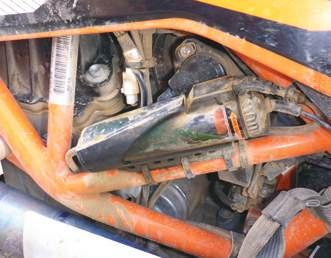
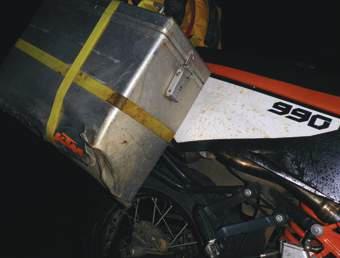




Just to put it into perspective, the west-east crossing of Australia is around 7000km. Across the USA it’s only 4662km, China is 6000km, and Russia is the granddaddy at 10,000km.
I’m not sure why (I think to see how long it will take an old bloke to do it), but John has invited me along to the pre-ride. We’ll have completed it by the time you read this, so there’s another big, big story on its way.
R The course is a big loop with seven designated starting points allowing riders to start without a huge travel commitment before the ride even begins
R Riders carry camping equipment because they’re expected to stop riding at 5.30pm for safety no matter where they are
R All riders carry a satellite tracking device
R GPS units are used for navigation
For more info, go to www.advridermag.com.au/ forum and click on the APC Rally thread.

The challenge is out there. Are you up for it?

commitments had always come first.
“Having been very much in the loop with what goes on with the courses over the years, I knew that this 2014 event was definitely going to be the best one to date, and without a doubt the ride and terrain quality didn’t disappoint me.
“John Hudson and the myriad of people in all the different areas who’ve thrown their local knowledge in to help make the ultimate 7500km track have to be congratulated. It amazed me how many times during the trip I turned on to
There wouldn’t be too many adventure riders with Craig Hartley’s experience in both competitive and non-competitive events. He rode one of his new KTM700RRs in 2014, and did a fair distance with only a single footpeg.
We still haven’t worked out how he did that.
Here’s what Craig had to say about the 2014 APC Rally.
“This was my first 14-day APC Rally, only due to the fact that work
small country roads or tracks that the normal person looking for an adventure ride would never find.
“My ‘ghost rider’ Ken Allen, who just kept turning up, did one of the early events a few years ago, and every time we pulled up after going through a good section, he kept saying how much John had come ahead in the


quality of the country we were riding through and the quality of the GPS navigation and set-up of the tracks. His favourite saying was, ‘This is real adventure riding.’
“I’ve ridden one very large chunk of Australia and many of the places we went to I’ve never ridden before.
“The other great thing about the APC Rallies is that you can do them at whatever pace you want. It can be treated as a scenic tour, a casual ride or a holiday, or you can ride it to give yourself a personal challenge to test your navigation skills, overall endurance and machinery. That was my plan.
“Something else about the Rally is it can be ridden with minimal dust and no waiting on corners for your mates.
“Having ridden some very out-there adventure rides, along with a few Safaris in the last 20 years, I honestly have to say that this APC Rally would have to rate as one of the best quality adventure rides I’ve ever been on. It’s just a shame I had to stop. On finishing the event I offered to go and sweep the course.
“I know we all say that about every ride we go on, but it’s not until you go and ride the course in 2016 that you’ll understand what I’m talking about. Not until you see the absolutely breathtaking places we travel to.”

We built the Tiger 800XC to be just like the Tiger 800, but with a little bit more.
Using the rugged Tiger 800 as a starting point, we added a pack of special o -road equipment so you can keep on going when you run out of tarmac.


1975. I raced there for about three or four years, and then came out here to Australia in 1982. I didn’t go back to racing, but I rode bikes and all sorts of other things here.

Rocky Creek Designs is a fairly new identity in Australian adventure riding, but it’s making a big impact. Owners, Janice and Greg Jansen, are a couple always in motion, even sitting on their verandah in Byron Bay, looking out over their coffee plantation, the pair seem to be having a ball taking over the world.
AdvR: You guys are both quite entrepreneurial. What sort of things did you do before you began manufacturing motorcycle products?
I started out mowing lawns and cleaning gutters and so forth, and then I went into computers. I was an analyst-programmer, and I did that for a long time.
I got bored with that, so I bought a drill rig and worked on building sites doing heavy drilling. I had an accident that crushed a finger, so I got out of the drilling business and went back to computers for a while.
Then we came up here to Byron and I became a coffee farmer.
AdvR: What was Janice doing at that time?
JJ: (Laughing) I wasn’t even born yet!
I emigrated to Australia from South Africa in 1981, and I was working for a cosmetic company as a marketing assistant. I worked for the same company for 10 years and was promoted to Publicity And Promotions Manager.
I met Greg in 1985, and in 1998 I started my own business selling promotional gifts.
AdvR: Was he a promotional gift?
JJ: (Laughing still) He was a promotional gift that didn’t cost anything.
AdvR: What brought on the move into bikes?
JJ: My promotional gifts business slowed down when everyone started going direct to China.
GJ: It really started out of necessity. Our business had dropped off and we had to do something. My passion has always been motorcycling, and we started with a little product called Helmet
Right: The NoNoise earplugs are a new product.



Hook. It was like a handbag hook, but you hang your helmet on it.
HelmetLok came about when we were at Phillip Island selling our Helmet Hooks. People kept saying, “Oh. I thought it was a lock.”
One after the other. Over and over. That went on for three days.
I was trying to work out why people wanted it to be a lock. I started looking at modern bikes and realised that they just don’t have helmet locks any more. We decided we had to do something about it.
We came up with the HelmetLok idea when we saw so many people with their keys hooked onto a carabiner on their belt loops. We thought, “We need something small like that.” But the problem with carabiners is they open inwards. We had to design a product that opened outwards, and of course, had a lock. We started sourcing materials and came up with HelmetLok.
AdvR: You have a good range of products now. Is HelmetLok still your main one?
GJ: It is.
We have distributors in Europe and the US, South Africa, Malaysia and Australia…we sell it worldwide. We also have warehouses in the UK, USA and Australia! It’s pretty amazing.
Janice has logged plenty of distance on adventure rides. The products get plenty of real-world testing.
JJ: Plus we sell branded HelmetLoks to Schuberth Helmets and HarleyDavidson worldwide.
GJ: It’s huge.
AdvR: Do you have to spend a lot of time with dopey magazine editors who keep forgetting how to set their combination?
GJ: We actually very rarely hear from people with issues.
We’ve got to the point now where if you mess it up, you’ve really gone out of your way to do something wrong.
AdvR: (Blushing) Oh.
GJ: If you do mess it up, we have a policy where you take it straight back to your dealer and we’ll replace it.
AdvR: The HelmetLok started things rolling for you, but you have quite a catalogue now. You had the courage to go into manufacturing products like the HelmetLok and lately the Motopressor Pocket pump and Tyre Gauge.
Still clean in the middle of nowhere. That’s some good presentation!



Sold all over the world, the HelmetLok has been a big success, and it’s Janice and Greg’s own design and manufacture.

A ride in Africa was a big highlight for the Rocky Creek Designs pair. Below: Greg sure does look different when he forgets to shave.

GJ: Absolutely.
It’s fun to dream up a product and see it on the shelves. But it’s a hard slog. It can take two or three years to imagine a product and then build it and get it into production and on sale. Adventure riding is my passion, so we’re keen to get stronger there.
AdvR: You don’t sell only products you manufacture, though.
GJ: A lot of our products come from around the world. Our gloves come from the US. NoNoise hearing protection is
manufactured in the Netherlands. We have a jack and DynaPlug which are also manufactured in the US.
We meet these people at trade shows around the world. They see what we’re doing and they come up to us and say, “We’ve been watching you. Can you represent us in Australia?”
That’s how we pick up a lot of these products.
AdvR: You’re very fussy about making sure the products work before you sell them, aren’t you?
GJ: Absolutely.
I test absolutely everything. And the other thing is, I have to like the product as well. We use every one of our products. They’re all great and they’re unique in some way.
AdvR: How long has it taken you to build
Rocky Creek Designs to where it is now?
JJ: We kicked off HelmetLok when we returned from a ride in Africa in 2010. It has been quite a big growth, and that’s why we’re still broke! (They both collapse in giggles).
AdvR: How was the Africa trip?
GJ: That was brilliant!
Janice organised the ride for my thirtysecond birthday…
JJ: It was his fiftieth!
GJ: …anyway, we went from Victoria Falls in Zambia down to Cape Town. It was 5000km or 6000km, 16 days, and it was just outstanding. I’m still talking passionately about that ride, and it was four years ago. Charley Boorman was on the ride as well, and he’s a fantastic guy, a really brilliant tour guide and as funny as hell. He’s become a good friend now.
AdvR: What did you guys ride?
GJ: I was on a 1200GSA and Janice had the F650GS – the detuned 800 twin that’s called a 700 now.
AdvR: It’s been a fairly meteoric growth for Rocky Creek Designs so far. What’s coming up for you guys?
GJ: I’m going to EICMA (Esposizione Internazionale Ciclo Motociclo e Accessori –one of the world’s premier motorcycle trade shows – ed) to help promote the HelmetLok and MotoPressor in Europe. While I’m there I’ll look around for new products. Janice is off to Birmingham to do the same at the National Exhibition Centre. They have a huge trade show there in November.
Aside from that, we have an upgrade for one of our products coming up, and I have a new tyre-related product I’m really excited about. We’re going to manufacture that, and we still have to get moulds made, patents through and all sorts of other things, so it’s probably eight to 12 months away.
We’ve also got a new tyre gauge coming up. It’s a fantastic little gauge. We already have the gauge that accompanies the MotoPressor, but this is a tiny little thing that fits in your pocket. It’s wonderful!
We’ll continue to expand our line all the time.

For a good look at the great range of tried-and-true products offered by Rocky Creek Designs, log on to www.rockycreekdesigns.com.au.





































BMW G 650 GS
650cc single cylinder
LAMS Approved
Standard Features
ABS (switchable), heated grips, optional low suspension or centre stand
Options Included Auxiliary power socket
Ride Away $9,990*

BMW G 650 GS Sertão
650cc single cyl Adventure Bike
LAMS Approved
Standard Features
Spoked wheels - front 21”
ABS (switchable), heated grips, alloy engine guard
Options Included Auxiliary power socket
Ride Away $10,990*

BMW F 700 GS
800cc inline twin
Standard Features
ABS (switchable), heated grips, on board comp., pannier fast., centre stand, white LED ind.
Options Included
Traction control, electronic suspension adj., tyre pressure monitor, comfort seat
Ride Away $13,490*



BMW F 800 GS
800cc inline twin
Standard Features
ABS (switchable), heated grips, on board computer, pannier fastenings, centre stand, white LED indicators
Options Included Traction control, electronic suspension adj., comfort seat
Ride Away $16,990*
For one couple, retirement meant a chance to climb on a bike and see the world. They kicked off with a BMW F800GS on sweep through South Africa.

The pale sunlight filtered in through eyelids clamped firmly shut.
It was 5:00am. We don’t generally acknowledge any more than one five o’clock per day, and this isn’t the one. But we were in South Africa and adventure awaited us.

TV-news images of South Africa aren’t always pleasant, and parts of the country aren’t. Those are the parts with too many humans in them.
We shrugged it off and decided it would be our next
destination. ‘There are places we might not want to be in alone,’ we thought. ‘But wasn’t that a bit of the fun?’ we asked ourselves? If not, why the hell are you reading this magazine? Go ride your scooter in your mother’s backyard.
‘Go the guided tour,’ we decided.
The pre-tour info from South Africa Motorcycle Adventures (SAMA) was excellent and we couldn’t wait to get started.
The ride was scheduled to start in Pretoria, travel briefly north up to Kruger National Park, and then down the eastern coast to Cape Town, a total of more than
4000km in 16 days. Our bike for the journey was the BMW F800GS, a popular choice for the mixed road conditions of city highway to Pothole City.
There are lots of tours through this area, but the SAMA guides were born and bred in South Africa and they’ve created the tours from their own love of the sites.
From pick-up at Johannesburg airport we headed to Pretoria, skirting some of the most dismal shantytowns and squalor imaginable. We tried not to look. Pretoria is South Africa’s capital,




Main: Ascending the famous Swartberg Pass.
Top left: Colourful wedding dancers, Steve Biko Township.
Left: Our route included many winding, mountain passes.
and it’s a juxtaposition of elite wealth and dismal squalor. But the ride started with just a brief tour of the city’s historic sites (it was a really good chance to check out the feel of the bike), and then headed north to Kwalta Lodge.
This is an incredible place, nestled in mixed scrub forests and savannah land. The cabins are thatched lodges and the main buildings are filled with amazing carvings of wildlife and native totems.
We were taken to the closest Zulu community, sitting next door to this sumptuous resort. Again, it was a shantytown of cast-off corrugated tin, many with the original premises’ painted logos. But here we were given a bit more insight. These people had been displaced from their homelands and were now seeking permanent lodgings. They don’t know whether they’ll like this place or not, so they throw up a temporary structure while they check it out. ‘Property’ and ‘homes’ are really a foreign concept to them. Some move in. Some move out. Meanwhile, even on this rainy day, they dance in the muddy streets. While waiting for our lunch, a local troupe came in dressed in full tribal regalia, writhing with exquisite moves and taunting the riders to join them. Their laughter at our clumsiness was genuine. Even just a few South African rand saw them well-paid.
We headed back to the lodge for an afternoon safari, via the safari truck. “Get used to it,” our guide advised. “They don’t allow motorcycles in the wildlife parks.”
“Why not?” we queried.
“Because you guys look too much like gazelles.”
Okay. Duly noted. In a South African game park, we look like food.
Next day we headed into the Kruger National Park, a huge expanse devoted to the ‘big five’ of South Africa: elephants, lions, rhinos, water buffalo and cheetahs. There were also hippos, wild dogs, giraffes, and other fascinating animals who were obviously too busy to push their candidacy for South African prominence.
We trundled past a lion lunch – four huge males wrangling over the remains of…something. It wasn’t an adventure rider, we



Top right: Thatched roofed Rondavels are the typical homes for subsistence farmers.
Right: Wildlife is abundant in Kruger National Park and the many game reserves.
Left: Riding the Wild Coast.
Far left: The wide beach at Coffee Bay.

were pretty sure. It was probably an impala (we hoped).
The next part of the trip held great scenery and extra rides off the beaten track. The scenery and riding is impossible to explain. We got tired of the word ‘spectacular’. The route down into Mpumalanga is known by local bikers as Motorcycle Paradise, and the scenery is made up of incredible rock formations alongside winding roads. The weather can be a bit of a bother and it was pissing down rain, so the pillions were advised to woose out and take sanctuary in the backup van. While the roads were passable, they were better done solo.
A minor technical issue surfaced in these conditions. The inside of the visor kept fogging up. It was easily cleared by opening it just a crack, but this would’ve


been the perfect day to test the pinlock visor designed to prevent fogging in these conditions. It’s a pity it was safely stowed in the duffel bag in the back of the van.
And on into Swaziland through a fairly intimidating border gate we went.
What a beautiful country. Incredibly happy school kids waved madly as we passed through (geez, I wish I’d had these kids when I was teaching).
A British protectorate from 1906, Swaziland gained independence in 1968, and with it, a king. King Mswati III, a direct descendent of the pre-protectorate royal family.
Apart from owning everything bar a few of the more decrepit cattle we saw herded along the roadside, the king has, at last count, 13 wives. He picks a new one from an assembly of topless virgins each year. In an interview a few years back he admitted he’d lost count of wives and fiancées (they don’t become a wife until they’re impregnated). How charming can marrying a king be?
Each stop was a photo opportunity, but the highly recommended sites were Oribi Gorge, Coffee Bay – the ride to ‘The Hole in the Wall’ is a hoot – and Knysna,



with its Cango Caves and ostrich farms. If you’re under 70kg you can actually ride an ostrich.
For beach fans, diving into the Indian Ocean’s warm waters is a lifetime thrill.
Weather can be variable along the coast and one day of heavy rain forced the pillions into the support van again as the riders navigated flooded, pot-holed roads. And, at which stage, the fogging helmet visor became an issue again. The pinlock visor was still stowed in the duffel bag in the back of the van. Yay.
So the pillions could lounge while the riders explored.

Jonothan Berman, part owner-operator of the SAMA tour, is not even yet 30 years old. He’s done these treks with his father, Darryl, for years. The tour lists the straight(ish) routes. Get to those points, and Johno can easily be persuaded to throw a leg over to see something more. But experience has taught him caution.

At Oribi Gorge we clambered into a 4WD driven by a local guide because the road was deemed too rough to risk taking the bikes. It was a short trip to the gorge
Top: The red cliffs of Blyde River Canyon.
Above: Traffic chaos is the norm in rural townships.
Left: The Hole in the Wall at the mouth of the Mpako river.
from the lodge so we didn’t feel we’d really missed anything by not riding.
We came out of the bush track and out on to the top of very tall cliffs. A small stream meandered along then fell over the cliff, creating a small but pretty waterfall. There was a very dodgy-looking tourist operation offering the opportunity to swing out off the cliff and over the gorge. We opted to walk over the gorge along a less-dodgylooking suspension bridge. It was necessary to tread carefully as the walkway had undergone numerous repairs to fix pieces that had fallen out.
Way off in the distant valley, and in sharp contrast to this beautiful natural attraction, was a huge cement factory.
Again, the juxtaposition of wealth and poverty seems a hallmark of this wonderful country.
As we headed south, the weather became colder. We were either hot and wet, or dry and cold. Perhaps we should’ve looked at the weather maps before coming on this tour.
We rolled into Cape Town and found a great celebration for those who’d done the ride and survived. We gathered our gear, handed the bike back and took a deep breath.
Where to next?








Not sure how to take those first, wobbly steps into adventure riding?
The Ulysses Club has a special Adventure Riders Group. That’s right, the Ulysses Club.

We first discovered the Ulysses Adventure Riders by accident when one of the group’s members, John Baker, set a rip-snorter of a course for the release of the Triumph Tiger 800XC back in 2011. John had some awesome riding up his sleeve, and he mentioned the Ulysses Adventure Riders. Since then we’ve bumped into them quite a few times, and they’ve all been top blokes.
John takes up the story from here…
Not many people know the Ulysses Club is actually a social club. It’s aimed primarily at mateship, but just happens to foster that mateship through motorcycles. And yes, you’d be forgiven for thinking that those

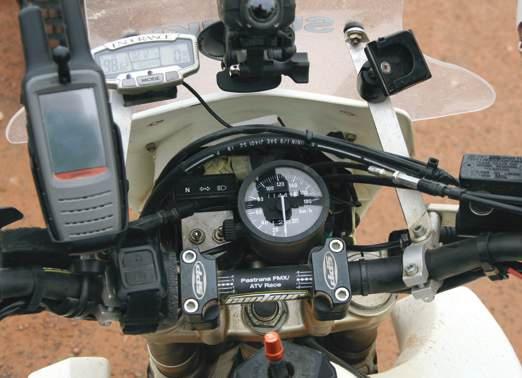
motorcycles are usually the kind that weigh north of 300kg – which isn’t too handy in Pooncarie mud. But there’s a bunch of us, a sizable bunch in fact, who are happy to get a little mud on our boots. In fact, we prefer it. We’re not a regional branch of the Club, but a nation-wide group of members who place adventure riding as their highest priority. For many that means not just for their motorcycling, but in life as well.
For a little over 10 years now we’ve been exploring the nether regions of this fair land, amassing some 200 rides as well as more than our share of top memories. Rides are graded into Easy, Medium, Hard, or Expedition. The grades are self-explanatory, with Expedition meaning long distances over extended timeframes with a willingness to handle the unknown.
Every year we host a major rally, inviting members to get along and swap a few lies over a couple of cold ones. These are always in some far-off, isolated location, and most riders form small groups for their ride to and from. This year, in what was a first for us, heavy rains west of Lake Gairdner forced the cancellation of the event just as most of us were within spitting distance, but last year we all met on a sheep station near Cunnamulla for a couple of days. It was an awesome event, and very much built on the tradition of the last decade, with about 70 riders arriving from all over Australia.
But it’s not all about a single event each year.
Every few weeks we have a planned ride over one, two or sometimes three-to-four days, mixing up the various grades of difficulty. That way there’s always something for everyone coming up in the near future. And speaking of everyone, we’ve always maintained a policy of inclusion. Simply put, we’re more than happy for people new to the sport to come along on one of our easy rides and get the feel of it. A big percentage of our regulars started that way, and have grown in confidence and skill over the years, becoming good mates along the way.
That’s not to say we aren’t fair dinkum about adventure riding. More than a few stories could be told around a





campfire of rides that have descended into unplanned challenges, usually weatherrelated. Snow and rain certainly ‘add’ to any ride...it is, after all, adventure riding.
But that spirit of mateship always pulls us through, and like the US Marines, we never leave anyone behind!
For someone wanting to get a toehold in the sport, knowing where to begin can be a challenge in its own right. There are guided tours of course, but they can give the ol’ credit card a hiding, often need prior skills, and where do you turn when the tour is over? Or if your mates aren’t as gung-ho about adventure riding as you, it’s easy to lose motivation. That’s where the Ulysses Adventure Riders can come in. Our current president is Gary “Chief” Wickham, and Chief is a seasoned member of the group, not to mention motivated. You can give him a call, or email him for more details. His contact info, as well as quite a bit of other stuff, is on our website www.adventureriders.org.
While you’re there click the link to our photo albums to get a glimpse of over 100 of our rides.
Oh, and don’t worry – you don’t have to be a member of the Ulysses Club to get along to a few rides. It’s a ‘try before you buy’ arrangement, so to speak. Over to you.


Adventure riding is still adventure riding. There’s lots of support from the group, but there’s still plenty of space allowed to everyone.


For heaps of yarns, pics, and information on the Ulysses Adventure Riders’ Group, log on to www.adventureriders.org.
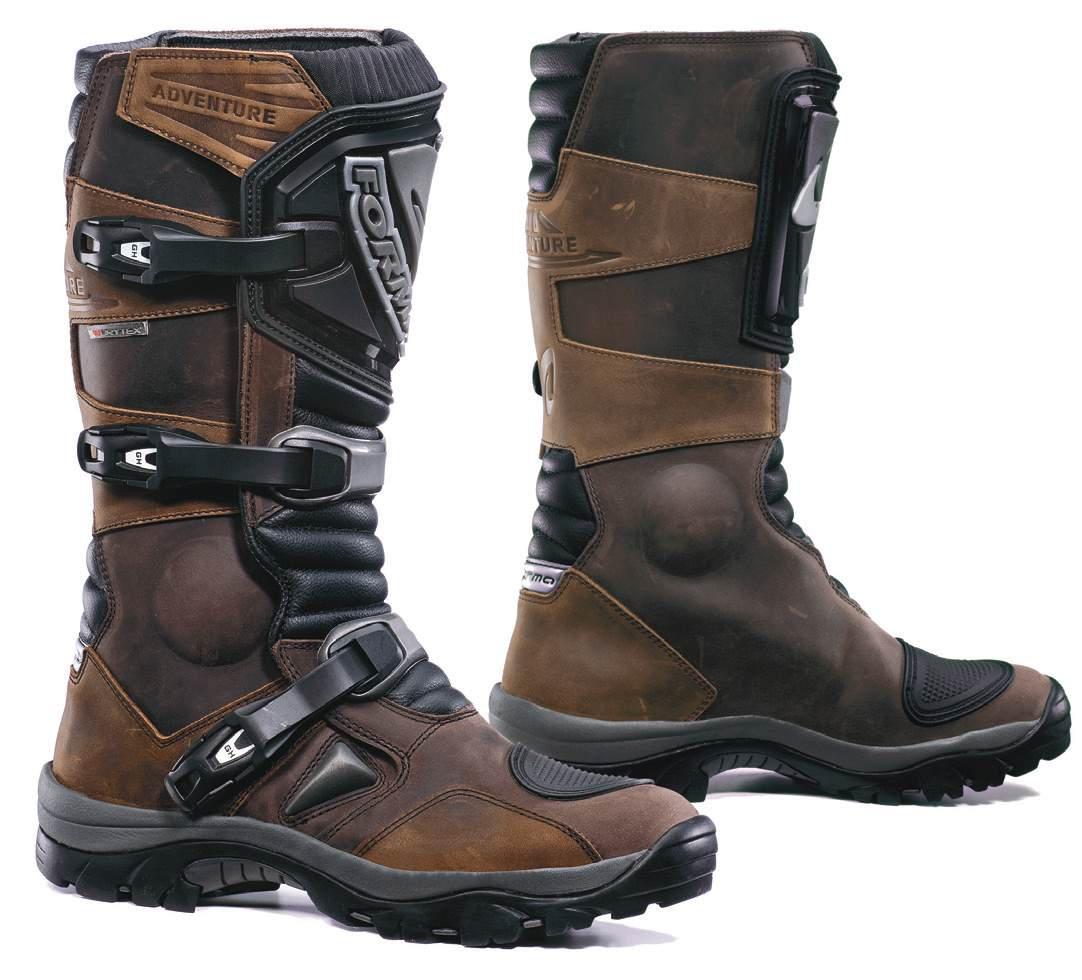


The brotherhood of adventure riders is growing fast. Now it’s a sisterhood, too! Everyone, meet…

Heather Baker
Q. Where’s home, Heather?
A. Quilpie, Queensland.
Q. What’s your age?
A. 40(+).
Q. Are you registered on the AdvRider Mag forum? If so, what’s your handle?
A. No.
Q. Oh. Well you should be. What bike do you ride?
A. KLR650.
Q. What’s the worst ride you’ve ever done?
A. None. Riding a bike is always a great experience. Don’t get me wrong. There are moments I feel out of my comfort zone, and even sore if I come off, but the freedom and excitement I feel override everything else.
Q. What’s your favourite place to ride?
A. Any place. I love the freedom of being able to get to places other vehicles can’t.
Q. What do you like most about the mag?
A. The stories of everyday people riding around Australia and overseas. Also, that you run stories from women and how they get on. I haven’t been riding long and I love to hear about other women riders as well as the men. It makes me feel normal.
Q. What’s something that really peeves you on a ride?
A. The lack of privacy for loo breaks. There’s very few trees in the outback. Sure, there’s not that much traffic, but you can be guaranteed as soon as you pull your pants down someone is sure to come along.
Q. Have you ever raced or ridden competition?
A. No.
Q. Do blokes get narky when you ride faster than them?
A. No. Most blokes think it’s great that I ride, and wish their partners would.
Q. Would you rather ride long distances or tough terrain?
A. Long distances, but I like to ride through different terrain. Not so much ‘tough’ terrain, but I really hate sand and we have plenty out here at Quilpie.
Q. Have you ever ridden with drum brakes?
A. No.
Q. Talk us through your luggage set-up.
A. The bike came with a Kawasaki KLR set-up (panniers, tail bag and tank bag). Mostly our rides are weekenders staying in accommodation. I bought dry bags that fit inside the panniers. They keep everything dry and they’re easy to lift out if you’re staying overnight. I’ve even used them as carry-on luggage on plane trips. Because my husband (see Ol’ Mate, issue #05) and I ride together, we usually share the gear, except for first-aid kits. We carry one each.

We’ve sourced a huge range of adventure bike accessories, luggage options, hard parts and clothing so you can create the ultimate adventure bike experience. Shop online or phone 1300 46 66 86 and let us help you choose the right kit for you.


Blackhawk Tank Bag
Our new mid size model
E12 Saddle Bags


Boulder Beta 60+ Litres
Expedition Dry Saddle Bags

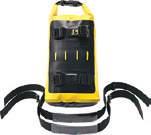

We now have stock of the new Klim Adventure Rally Suits.



Rack-less saddle bags that combine generous capacity with versatility and an out-of-the-way fit
Top Racks
Durable aluminum top rack with a uniquely functional design

Universal Straps

Expedition Dry Duffel - 3 sizes
Fully waterproof roll-top saddle bags tough enough for extreme conditions and rugged adventures
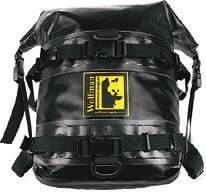
Waterproof, roll-top duffel bags built from tough vinyl make the perfect catch-all bag, especially in wet or dusty riding conditions
These straps will allow you to mount our bags on any rack system.

Coyote Saddle Bag For hardcore off-road expeditions


Rolie Bag System - 3 sizes
Globe Scout is constructed from highstrength aluminium magnesium alloy material with a bifunctional lock system, stainless steel rivets and locks. 35 litre Side Panniers

40 litre Top Box
Possibles Pouch
Increase the carrying ca pacity of your saddle bag.



Giant Loop PRO Tank Bags
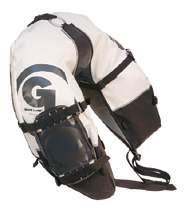
Fandango Pro and lower profile Diablo Pro. Tillamook and Rogue Dry Bags



Racks available for BMW, Honda, Husqvarna, KTM, Kawasaki, Triumph, Suzuki and Yamaha

Hard Parts for most makes & models


Great Basin Saddle Bag
Large volume capacity for larger dual sports and adventure bikes.






Garry Haydon from South Aussie sent us this issue’s dream image, and it’s a pearler. Gazza reckons photography is a passion for him. This pic was himself and a mate going for a weekender. Haydos snapped off the shot just before Robertstown, SA, then the blokes continued on to Burra for a counter meal before heading out to camp.

Garry has earned a terribly exclusive AdventureRider Magazinepolo for sending in this clear, sharp image and making us all admire his photographic skillz. If you have a pic you’d like to share, email it to tom@advridermag.com.au with your details and some brief info.


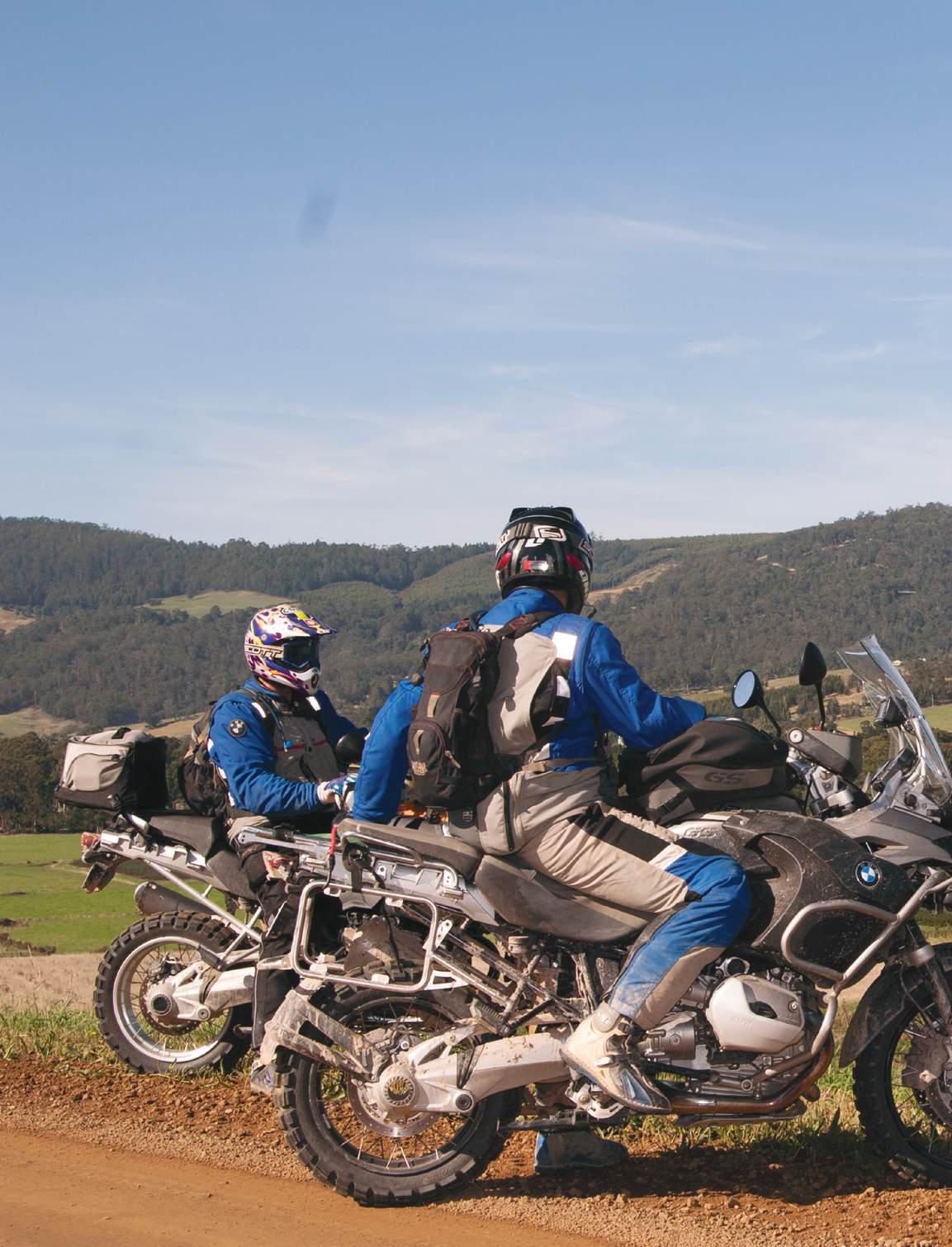

Ask anyone who’s ridden the exotic locations of the world and they’ll tell you Tasmania is one of the most beautiful, unique and amazing adventure-riding destinations on the planet. But instead of asking someone who’s been there, you could find out for yourself.
Do you long to ride through dank, primeval forests where man has yet to make any significant mark?
Do you crave the winding, wet roads beneath the canopy of centuriesold eucalypt?
Can you imagine yourself sitting on your bike, high on a rocky mountainside, looking down over the stark, white sand and gazing out across the turbulent, churning waves of the Tasman Sea or the Indian Ocean?
There’s no need for it to be a dream. In October this year, just a couple of months from now, a team from Adventure Rider Magazine is going to live all those incredible fantasies and more.
We’re so damn excited about it we can hardly breathe. And of course, you can join us if you’d like to.
The details of the ride have been public for a while, but in case anyone missed them, here’s what we’re planning:
v Five days in one of the world’s greatest adventure-riding destinations
v Staying in pubs and similar accommodation
v Brekky, lunch and dinner supplied
v A support vehicle
v The routes available on GPS, AND v Guides who’ll show us the very best sites and most premium riding this fabulous place has to offer. That’s what we’re planning, and the cost to be part of it is $2350.
You’ll have to buy your fuel, alcohol and any tucker
outside those regular meals we’ve listed, but Trek Tasmania is about the ride experience of a lifetime. The rest is up to you.
Most mainlanders will want to put their bikes on the Spirit Of Tasmania and cross Bass Strait overnight. So the ride will start from Devonport in the northeast of the state. That way we can all roll off the ferry and start looking for egg’n’bacon rolls and coffee immediately, then start riding straight after.
Of course, those who want to get there earlier, or who maybe even live there, can just roll up and meet us to start riding.
Riding where?
We’re glad you asked.
Jason Gale is one of the guides who’ll be showing us around, so we gave him a call to get the good oil.
“I’ll be doing the final three days,” Triumphed Jason. “Rick (Trickett) will guide the first two days, but I’ll pick you guys up from Hobart on Tuesday night, and I plan on taking you out through Huonville, and then back up through The Styx Forest. There’s some massive trees in there, and they make for sensational photos. Some of the trees are hundreds of years old and four and five metres in diameter. They’re incredible! Then we’ll head up through Fourteen


primeval forests? Check! Image: BMW Motorrad/ikapture









Mile Road. There’s some sensational old timber pipelines from the hydroelectric scheme I’d like to show you guys, and from there we’ll head up to Derwent Bridge for lunch.”
Lunch! Yum. We liked the sound of that bit.
From Derwent Bridge Jason plans a bitumen run down the famous ‘99 Bends’ – The Lyell Highway – into Strahan for the night.
Just the name ‘99 Bends’ is enough to get us excited. And we know what an amazing, gorgeous village Strahan is.
So that sounds like a great day’s Tasmaniaering to us.
But Jason was only just getting started.
“The forests are archaic,” he timbered on, “and you’re guaranteed to get wet down there.”
Wet. Ew…note: wear the Klim suit.
“I did have a dry ride down there recently,” he dampened, “but that was a fluke.”
So there’s a tip: bring your wet-weather gear, and be ready for a cold day or two. You’ll be carving through the 40-degree latitudes on this ride, and the weather can be all over the place.
“We’ll head to Hells Gates, too,” continued Jason, just as we thought he’d finished for the day, “And those who want to can go for a blast along the beach if the tide’s out. It’s legal there, and a beautiful place to ride.
“We’ll come back in from the beach and bunk down for the night in Strahan.”
We’ll all need a sleep after a day like that.
Jason had heaps more to talk about, including slick, white gravel, The Corinna ‘Fatman’ Barge, the Western Explorer, lookouts, Couta Rocks, Smithton, a full afternoon in the scrub to get to Burnie, heaps more forestry riding, Tabolt’s Lagoon to park on the dam wall, and so much more we could hardly keep up.
“On the last day we’ll get lunch at Sheffield,” explained the Tiger rider, “and being the last day, we can cruise through the afternoon. But if anyone wants more we can do another loop out through Deloraine, the State Forest and into Devonport to meet the ship.”
Phwoar. It sounds awesome.
It IS awesome!
With all his intimate knowledge of Tassie and the areas we’ll cover, we were drooling to know which bits are Jason’s favourites.
“Rabalga Track is just one of my favourites,” he said thoughtfully. “It’s after lunch at Smithtown, and that’s one blast of a track. It’s sweeping, flowing, mosscovered…it’s just really beautiful. And we’ll get a look at Dip Falls. They’re absolutely magnificent. The water’s a spectacle, but the rock formations are incredible as well.”

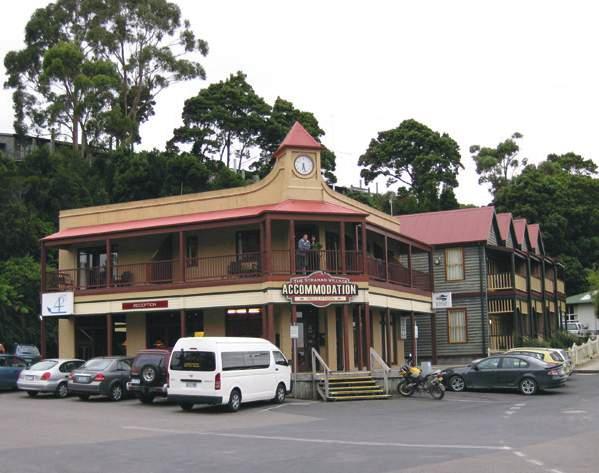
We had to tear ourselves away from the landscapes Jason was painting in our minds and turn to more mundane matters…like tyres and bike prep.
Jason said riders would get by on road tyres, but he didn’t sound very convincing. He brightened up considerably when he suggested true 50/50-type tyres, so that’s what we’ll be fitting. Riding apparel to handle the cold and wet, for sure, so we’ll have the Klim suit and Andy Strapz thermals, a fuel range of around 270km, camera of course, tools to do basic maintenance and, best of all, a spirit hungry for exotic adventure.
And having thought of all that, don’t forget we haven’t talked about the first two days yet! Phwoar.


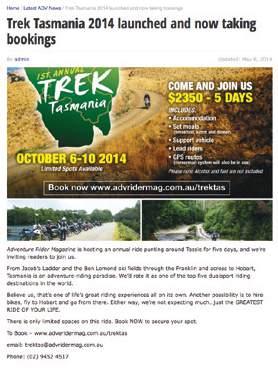
For the latest info on Trek Tasmania or to book a place on this mind-blowing ride, go to www.advridermag.com.au/trektas. You can email: trektas@advridermag.com.au for more info, or, if you’re really stumped, try phoning (02) 9452 4517 during business hours.






A What to look for. What to look out for.
s modern bikes offer increasingly higher levels of performance the issue of protecting vital components becomes more critical. More and more cheap copies of good product are hitting websites and bike-shop shelves, and it’s getting tougher to work out what’s solid gold and what’s just bling. Radiator guards are a good example.
There’s no doubt a bike’s radiator is a high-exposure component of a complex system. To perform its function properly a radiator pretty much has to be out there, figuratively, and sometimes quite literally, swinging in the breeze. And because a radiator is a heat exchanger it relies on big surface area and thin-walled channels of fluid.
Put something of that description on a bike designed to be ridden through mud,
rocks and scrub, or even designed to be ridden at speed on loose surfaces, and suddenly protection for the radiator takes on a very high priority. It’s not that the

Above: Paul and his team have been making radiator guards for 14 years.
Left: Supplied with all fixings and very detailed instructions. Some Rad Guard products even have instruction videos available on Youtube.
just how tough things can be in Australia. Paul Voglsinger and his team at Rad Guard have been designing and manufacturing radiator guards for 14 years. Rad Guard makes a premium product refined by use in the real riding world. What made Paul get into making radiator
“In 1997 I and a few other riding buddies holed our radiators over a short period of time,” remembered Paul. “In 1998 I purchased a new bike and wanted to protect the radiator to avoid what happened to me in the past. But when I went searching for a product I couldn’t find anything, so I manufactured my own and for friends.
“There’s more than just a cooked motor to consider from radiator damage.”
manufacturers don’t take radiators into consideration when they’re designing bikes, but as we see with so many components, very few manufacturers seem to understand
“Two years later when I took that guard off, the radiator still looked brand new. In the meantime, a lot of people had asked where I’d got the guard from. When I saw how well my radiator had been protected, and the number of riders who wanted guards, I thought, ‘We have to do something here.’
“We launched Rad Guard at the 2000 Phillip Island GP with 10 different types of guards. We’ve now expanded the range to over 350 makes and models.”
What makes for good radiator protection?
Not so much bracing in this case, because unlike enduro bikes, the adventurers seem to have their radiators far more enclosed, often by large fuel tanks and crash bars. But the radiator cores are still very vulnerable.
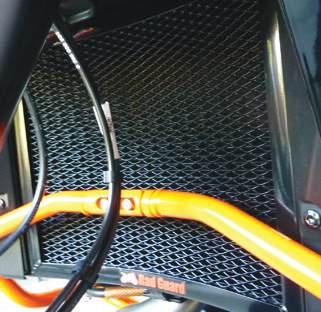
Guard HQ and sat down for a coffee – these guys do a particularly nice morning tea using a forklift with a pallet as a table – to look things through.
As we slurped away on a Nescafé and enjoyed the sun, Paul ticked off the main points a buyer should consider:
v The guard shouldn’t restrict airflow
v The guard needs to be strong enough to survive high-speed impact from projectiles
v The mounting system is important, and

v The guard shouldn’t vibrate
There’s more than just a cooked motor to consider from radiator damage. What if coolant leaks out and blows onto the tyres?
The unexpected loss of traction could mean something far worse than mere mechanical drama. And in any case, even if there’s no engine damage from overheating, the cost of replacing a radiator can be devastating, and being stranded somewhere is a pest.
lot

instructions in plain English.
As we flicked the crumbs from our shirtfront Paul gave an interesting demonstration of the importance of how the protective expanded mesh is fitted. If the mesh is viewed from one direction it appears an open lattice. But, thanks to the angle of the apertures, viewed from the opposite angle it appears an almost closed, solid sheet. If the guard is made with care, the mesh is fitted to its supporting frame in such a way that debris flicked up from the front wheel hits the mesh that deflects it from the almost solid face, while the air still has free access from the reverse angle.
Tricky, or what!
That supporting frame should be robust, but not a dead weight. Rad Guard uses high-grade aluminium U channel, and it gives a lot of strength to the shape of the mesh.
We’ve seen plenty of examples where the mesh is either not angled, or is installed any old way, so that’s something we’ll be looking out for in future, as well as how the mesh should sit about 12mm to 15mm off the radiator core. That allows the mesh to disperse the energy of a projectile without touching the core itself.
There’s a few other things that we’ve never thought of. Paul pointed out that his guards are supplied with a foam backing on the frame to prevent any vibration or rattling.
Above: For those who prefer the ‘stock’ look for their bike, Rad Guard offers both powder-coated black and polished-alloy guards.
Quite a few customers preferred a guard that was near invisible so they offer powder-coated black as well as polished alloy, and all the Rad Guard guards are held in place with bolts through welded brackets. Finally, the Rad Guard products are supplied ready to fit, with all fixings and instructions, and of course, they’re Aussie-made.
We’re sold!


To find out more about Rad Guard and their range of guards, log on to www.radguard.com.au, or give them a call on (02) 6658 0060. Make sure you ask Cindy what’s on the menu for smoko!


There aren’t too many bikes around that can compete with Triumph’s Tiger 800XC when it comes to putting the sport in dualsporting.
Of the British bike manufacturers, Triumph has probably the most envied reputation. There’s a lot of history associated with the marque, especially after the current, very successful Triumph company rose from the depths of bankruptcy in 1983. In fact, going broke and then becoming hugely successful seems to be almost a mark of pride among motorcycle manufacturers these days.
Whatever. Triumph, for all its fans, is the bike Steve McQueen rode and the bike that gave British motorcycles credibility. It’s still the largest British bike manufacturer, the bikes from the modern era are as sexy as hell, and best
of all, Triumph has the in-line, threecylinder motor that’s an absolute, 14-carat-gold screamer. It’s the heart of the Tiger 800XC.
The Tiger XC first appeared in the 2011 line up for Triumph and the media launch was a bit of an eye-opener. The Tiger looked and felt like a road-oriented bike, but Triumph Australia had the magaziners pound those 800s through some seriously tough terrain and the bikes did it easy. They crossed deep creeks submerging the engines and smashed some very impressive hills. The bikes earned huge respect from everyone.


Since then the Tiger’s been steadily increasing its followers and it’s easy to see why.
The motor is the three-cylinder, fuel-injected, liquid-cooled unit that’s proving a huge winner for Triumph. The stocker offers just short of 100hp, but as we saw with the Explorer in issue #03, the power delivery is amazingly linear. There’s no explosion of tyreshredding terror at any point in the rev range. It’s all just smooth,



Above: At the model release in 2011 the test riders were encouraged to punish the Tiger. The bike coped with everything asked of it.
Below left: The bashplate and crash bars fitted nicely and did their job well.
manageable, clean-driving fun, and that goes for on- or off-road. On the bitumen that subdued snarl begs the rider to press on, as hard as he dares, into the winding, mountain twisties. On the dirt it revels in cracking the throttle open, breaking the rear end free and getting plenty of controllable sideways motion happening.
It’s a joy to ride, and a rewarding experience to ride hard.
The motor’s the shining light of the Tiger for us, but the whole bike is pretty damn good.
For starters there’s a feeling of quality about the build of Triumphs that’s very satisfying and can’t help but inspire pride in an owner. We’re not suggesting they’re way in front of any other manufacturer, but there’s just something about the finish and feel that’s really nice. Even the fittings like the bashplate, gauges, and that distinctive double-rail trellis frame all just seem strong and well-made, and after half a lifetime spent on bikes with plastic tanks, bikes with beautifully

The Tiger is on the prowl. Its prey includes dirt roads, trails and winding, ’peg-scraping bitumen, all of which it devours with relish.
painted steel tanks make us feel all gooey and smitten.
The seating position will be comfortable for most average-height riders, although the seat might be a little on the soft side. We only mention that because one rider brought it up, only to be shouted down by others who thought the plush seat was ideal for long-distance travel. Along with the comfort of the seat goes a good screen that, like the seating position, should suit riders who aren’t beanpoles.
Suspension is fine for the bike’s intended purpose. It won’t cop being pancaked from two metres off an erosion mound, but it’ll deal with dirt roads and rough trails, and on the road the bike holds its line well under hard cornering. We even got a bit courageous with it, largely because it was making everything so enjoyable.
Triumph claims 220mm travel at the front and 215mm at the rear, and for 99 per cent of Tiger buyers, that’ll be plenty. More important than the travel is the action, and again, for the bike’s intended purpose, we reckon it’s about right. It can


“Twins are for pussies. Those bikes are prey for the Tiger! ”
be personalised and improved, as can any bike, but any rider who says they won’t tackle a trail or set of bends on the Tiger because the suspension’s not up to it is probably suffering from a pulled heart muscle.
The bike you see in the pics here had ABS, and that’s no surprise. In fact, from January 1, 2016, all bikes over 125cc will have to have factory-fitted ABS to comply with European legislation, so we might as well get used to the idea.
The ABS on the Tiger is switchable via the two buttons on the instrument panel (we admit we couldn’t work it out. We had to ask the Triumph guys). Like all bikes, the ABS defaults to the ‘on’ setting every time the ignition’s switched off, and that’s a bit of a pain. At least modern ABS is getting so good there’s no need to turn it off unless things get extreme, and that goes for the


Triumph system as well. On the road riders won’t notice it unless they need it. Off-road, the rear tends to kick in at times we’d rather have been without it. It didn’t cause any problems, and the front worked really well. For steep downhills a rider will still need to pull up and ensure the ABS is off, but as we said, in a very short time that’s going to be the case on all adventure bikes.
The twin-disc Brembos at the front were really nice. They weren’t ridiculously strong, had great feel and were a pleasure to use in all situations. The rear was the same, except the ABS seemed to cut in a little more often, possibly because we’d unweighted the back end a little, us being so rough’n’tough and braking so late and everything.
We confess to having a huge affection for the Tiger. Ever since its release we’ve looked for every chance we could to get back on
Top: Hoo-aah! What a motor! All the wild and exciting sting of an in-line, multicylinder powerplant with a sensational pedigree, yet still easy to use and a beautiful, even power delivery.
Above middle: We’re not sure just how much the Arrow pipe affects performance. The bike still had a sensational multicylinder growl and was still a long way short of loud. The Arrows are a Triumph accessory in Australia.
Above: Nice and simple. Phew.
one, and every time we do, we love it more. At the Touratech Travel ride last issue the Tiger had us wearing a 24-hour, ear-to-ear grin. Braking is excellent, handling is good, the motor rocks, and the comfort level is high. What else is there to say about the Tiger?
Not much.
As far as we’re concerned, this is a great bike, and especially a great dualsporter.
Until the Tiger’s put to the test, it’s hard to believe just how tough it is. It’ll handle some way, way snottier terrain than the look of the bike would suggest. It’s a lot of fun finding that out.


BI ke s P e C s

The gauges are clear and easy to read. There’s not too much technical overload on the Tiger.
Off-road it’s no enduro bike, but it’s amazingly capable and will tackle obstacles that seem way outside its design brief. On-road it’s a scorcher. That motor makes a rider feel like he’s a dead-set road racer, and we defy any normal, red-blooded adventurer to not suck up the red mist when there’s a section of winding bitumen presenting itself, especially if there’s a few other
Web: www.triumphmotorcycles.com.au
Rec retail: (with ABS) $15,990 plus ORC
Engine type: Liquid-cooled, 12-valve, DOHC, in-line three-cylinder
Displacement: 799cc
Bore/stroke: 74.0mm x 61.9mm
Rated output: 95PS (93.6hp) at 9300rpm
Maximum torque: 79Nm at 7850rpm
System: Multipoint sequential electronic fuel injection
twins trying to set the pace. Twins? Twins are for pussies. Those bikes are prey for the Tiger! On a more mundane level, peeling off big distances on dirt and bitumen is almost too easy. The motor is hardly working at all at freeway speeds, the screen and seating position are sweet, and the bike is so incredibly willing. Who wouldn’t want one? triumph 800xC tiger

Exhaust: Stainless steel 3 into 1, high-level stainless steel silencer
Gearbox: Six-speed
Final drive: O-ring chain
Clutch: Wet, multi-plate
Oil capacity: 3.7 litres
Starter: Electric
Fuel tank capacity: 19 litres
Transmission: Six-speed
Frame: Tubular steel trellis
Swingarm: Twin-sided, cast aluminium alloy
Front suspension: Showa 45mm upside down forks, 220mm travel
Rear suspension: Showa 45mm upside down forks, 220mm travel
Front wheel: 36-spoke 21 x 2.5 inch, aluminium rim
Rear wheel: 32-spoke 17 x 4.25 inch, aluminium rim
Length: 2215mm
Width (handlebars): 865mm
Height (without mirrors): 1390mm
Seat height: 845mm/865mm (adjustable)
Wheelbase: 1545mm
Brakes front: Twin 308mm floating discs. Nissin twin-piston floating calipers (ABS model available)
Brakes rear: Single 255mm disc. Nissin single-piston floating caliper (ABS model available)
Wet weight: 215kg
Dry weight: 190kg


Kawasaki could be forgiven for not spending any R’n’D budget on the tried-and-true KLR650. Believe it or not though, Kwaka looked hard and found a few small improvements that actually make a surprising difference. We say ‘surprising’ because we thought the bike was already pretty damn good in the first place.
If you check the specs panel we’d forgive you for wondering why we’re having another look at the KLR. It appears that nothing has changed. It has.
Just to cover off the technical side, the KLR we rode, the bike you see here, uses a single-cylinder, dual-overhead cam, 651cc, liquid-cooled, four-stroke motor with dual counterbalancers, and a cable clutch. It’s fed its fuel by a CVK40 carburettor, the forks are 41mm jobbies and the single-shock rear offers adjustable preload and rebound.
Just looking at that spiffy, metallic green paint and walking around the bike, we really couldn’t see any difference. That was fine with us. We loved the KLR last time we rode it.
Hell. We even bought one.
It’s what’s inside that counts
Flicking through the supplied notes it seemed the bike earned its designation ‘New Edition’ thanks to a contoured seat and a suspension upgrade.
“Big deal,” we thought. “A new seat.” No wait… Suspension upgrade?
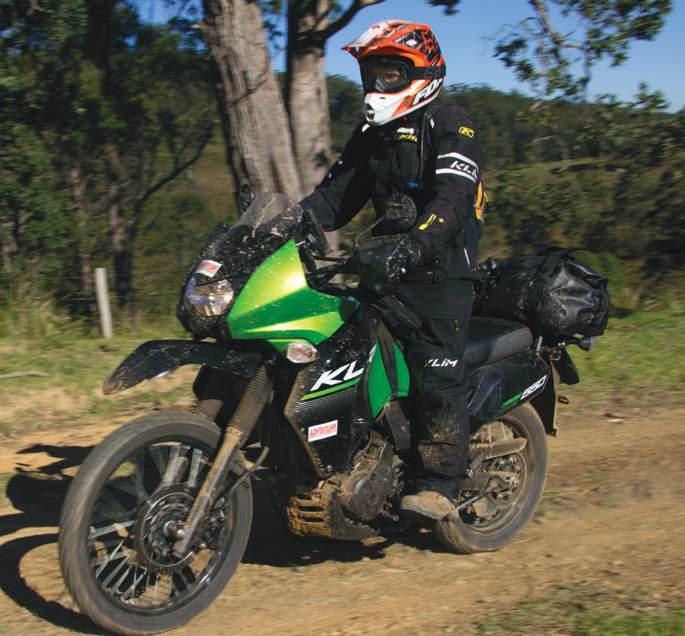
That’s potentially serious.
Rapt at having a good excuse to thrash someone else’s KLR, we leapt on board, touched the starter and relaxed into that happy and smiling state the Kawasaki always brings us. No gadgets or marketingdepartment-inspired design tweaks, just an honest, hardworking and reliable motorcycle. It gets us every time.
First thing’s first.
The cockpit and feel of the bike is unchanged. Our initial impression
u
Main: The KLR has always been a great bike. Now it’s even better. The New Edition is available in Lime Green/Ebony (the bike you see here), or Raw Graystone/Ebony, and there’s a stack of luggage and genuine accessories available at Kawasaki dealers.
Top right: Dirt roads, long bitumen hauls or destroying huge desert distance. The KLR is ready for all of it.
Bottom Right: The new seat is narrower at the front and wider at the rear. It also has a ‘dimpled surface’.

was that this could’ve been the same bike we rode a few months ago. The new seat shape and surface doesn’t make a big difference when you first climb on board, and everything else is the same.
We were lucky enough to have our own 2009 model along on the test ride, and there’s no doubt in a side-by-side comparison the seats are different. Not only that, the new seat is more comfortable. The narrower shape at the front makes it a little easier to grip the bike with the knees, and it doesn’t seem to bunch or wrinkle under the bum after a while the way the old one did – unless that’s our tired old bums bunching and wrinkling. Ew.
The textured seat cover is a definite improvement. Kawasaki calls it ‘dimpled’, and it offers a better feel as a long ride wears on. It’s not a big deal, but it’s undeniably an improvement.
We have to be honest, though. Without the old seat right there to compare to,
we probably wouldn’t have picked it.
As we flanged along some glorious northern NSW dirt roads, swooped through bitumen turns, splashed across creeks and wobbled along some very treacherous clay, our hearts beat strong for this wonderful bike. And the more we rode, and the more we swapped back and forth between the New Edition and ours, the more impressed we became with the suspension on the later model.

“ We think these more restrained modifications are brilliant.”
It’s not a punch-in-the-face difference. We didn’t find ourselves marvelling at the KLR’s increased capability and comfort inside the first 20km. But as the four-day ride wore on, we noticed again and again just how much more sure-footed the new bike was on the shitty, choppy sections. In issue #03 we said the stock KLR suspension was ‘surprisingly good’. That made us even more surprised it’s been improved.
Overall, both ends feel firmer and give more feedback to the rider. The KLR now

Above: A tool kit supplied! Excellent! And we love the little compartment built into the rack.
Left: A brilliant sightseer. Above right: Nothing new here. The same easy-to-read set-up as before. Above far right: The seat is the only visible change. And those scratches on the shroud, of course (d’oh).

gently encourages a little more aggression in turns over rough ground, and feels a little more confident on pushing through a genuine trail where the bike gets slammed by tree roots and big ruts. Kawasaki claims stiffer springs and revised damping both ends, and while it must’ve been tempting to make big changes so everyone would talk about it, we think these more restrained modifications are brilliant. The heavier springs make the bike even more of a pleasure to ride – and that’s saying something – as well as giving riders a big head start when they start loading luggage. It’s as though someone at Kawasaki said, “Let’s just remember the type of riding this bike’s designed for, and what 99 per cent of owners will do,” and the design team, and even the accountants, listened.
While the motor and geometry is unchanged, we reckon the suspension upgrades – they’re definitely upgrades – make this a noticeably faster bike. It’s more comfortable too, not because of any ergonomic changes, but because across long days it asks just that bit less of the rider.
There were a couple of things that caused us to frown.
We loved the big, flat rack with lots of tie-down points, and we especially love the little tool holder set into the rack. Our ecstasy soared to new heights when we found a toolkit supplied with the bike – just like the good ol’ days. But then, for some reason we couldn’t understand, there was no eightmillimetre spanner in the supplied kit. There’s plenty of eight-millimetre bolts on the bike – it needs an eight-millimetre to get to the air filter for starters. Bummer.

Also, the handguards that we thought would be the cat’s meow when we saw how much protection they offered from the wind, turned out to be a bit of a mixed blessing. They tend to work loose, and at freeway speeds the wind folds them back on to the rider’s fingers. If the wind blast gets strong enough the handguard can even begin to move the levers.
And of course there are the same rubber-topped footpegs that we found so slippery when they were wet last time.
We only mention those things because we feel it’s just not right to rave about a bike as much as we rave about this one without having something to balance things out.
That’s all we’ve got, though.
Go back and read the test in issue #03. Everything we said about that bike applies to this one. It’s smooth, quiet, comfortable, and ready for a run to the shop or an odyssey to Cape York. The 22-litre fuel tank is brilliant, the thing’s as tough as buggery, and while it may not have the horsepower or technical trickery of some other adventure bikes, not everyone wants those things.
On top of everything else the KLR offers it has a reputation for reliability that’s pretty hard to match. Now it has all that and better suspension…oh, and a nicer seat.
All for an extra $100.
Congratulations, Kawasaki. We tip our autographed black caps to you for a job very well done.

Web: www.kawasaki.com.au
Rec retail: $8099 plus ORC
Engine type: Liquid-cooled, single-cylinder, DOHC, four-valve, four-stroke
Displacement: 651cc
Bore/stroke: 100.0mm x 83.0mm
Compression ratio: 9.8:1
Fuel system: CVK40 carburettor
Ignition: CDI
Clutch: Wet multi-disc, manual
Starter: Electric
Lubrication: Forced lubrication, wet sump
Transmission: Five-speed, return
Final drive: Chain
Frame: Semi-double cradle, high-tensile steel
Front suspension: 41mm telescopic fork
Rear suspension: Bottom-Link Uni-Trak with five-way adjustable preload and stepless rebound clamping adjustment
Brakes front: Single 280mm petal disc with twin-piston calliper
Brakes rear: Single 240mm petal disc with twin-piston calliper
Fuel capacity: 22.0 litres
Length: 2295mm
Width: 960mm
Height: 1350mm
Seat height: 890mm
Wheelbase: 1480mm
Ground clearance: 210mm
Kerb mass: 194kg (including full tank of fuel and all fluids at correct levels)


Whatever happened to BMW’s good ol’ 650 Dakar? It became the Sertão, and it took a few big forward steps in the process.
BMW’s 650 singles – we’re not going to try and untangle all the names and model designations they’ve had over the years – have been almost quiet achievers. We say ‘almost’ because it’d be difficult to find someone who didn’t know of the bike’s reputation for reliability, but when you ask for any more than that, everything gets vague.
Before the current crop of amazing, high-performance road bikes and the incredible GSAs, BMW’s 650 single used to quietly go about its business, toting riders and large luggage loads all around the world with a minimum of fuss. They were brilliant commuter bikes and lightweight long-distance travellers, too.
Bikes like the F650GS and Dakar never offered startling performance or amazing horsepower, and maybe that’s why they didn’t get a lot of attention.
Now the G650GS unarguably carries on the tradition, but where the Dakar model used to be a little light on for suspension and horsepower, its newest incarnation, the Sertão, has conspicuously more to offer than its predecessor.
On a foggy, wet ride over slippery clay, rock and bitumen, we put the baby BMW to the test and came away very impressed.
Pinning down the features of the Sertão starts with the 652cc, liquid-cooled, four-stroke single. It’s the same motor, give or take, that’s been the heart of these bikes for a long, long time, and it’s a bottler. BMW claims 48 horsepower in stock trim, and that’s pretty respectable in this section of the adventure-bike market. The donk drives through a five-speed gearbox via chain to a pair of spoked wheels – 17-inch at the rear and 21-inch at the front. That’s a great combo for tyres and general off-road riding.
The seat is a wide, firm unit and the compact dashboard sits behind a small screen that’s surprisingly effective. We’re still a little puzzled at how such a small piece of plastic can keep us in such a sheltered bubble, especially on the road. It does, though. No problem.
Of course the motor is fuel-injected, and ABS and heated grips are both standard on this model.
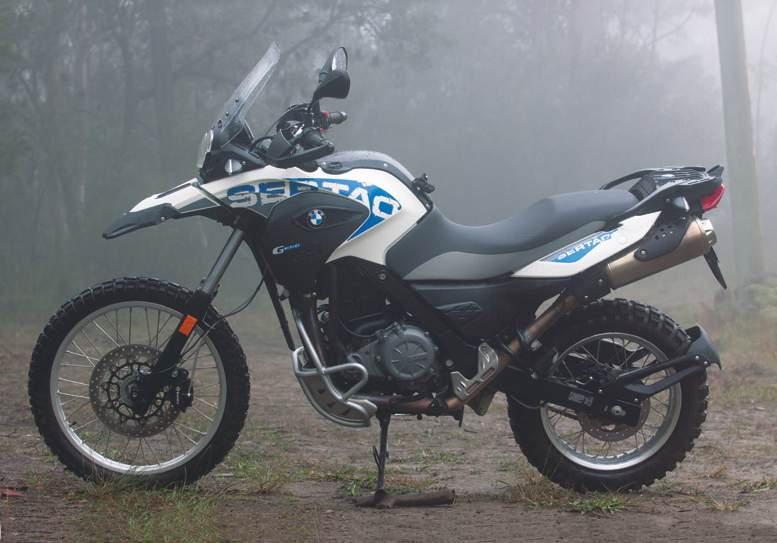
So at first glance, the Sertão looks a good proposition. But when you take the price into account, it suddenly becomes an amazing proposition.
The first impression of the Sertão is one of comfort.
The seat is generous, the cockpit anything but cramped, and the instrument display is clean, clear and easy to read with just a glance. Touching the button fires up a very quiet engine and hardly any vibration makes its way to the rider through any contact point. We were relaxed before we even blipped the throttle for the first time.
Even the ABS is too easy to sort out. If you want ABS to do its thing, just click the bike into gear and ride away. The anti-lock angel will be watching over you. If you’d rather take your braking fate into your own hands, just thumb the red button on the left switchblock until the warning light on the dash stays
Left: Like the rest of the GS range, the Sertão will go just about anywhere.
Right top: This handy little hatch can hold a few bits and pieces, and also gives access to the catch for removing the seat.
Right middle: It’s all pretty tidy, front to back and top to bottom. Even under the seat looks well-organised.
Right: The distinctive BMW 650 styling is still there.




on, and you’re done. So nice and simple! Even better, if you’re riding along with the ABS switched on and see a steep descent ahead, just pull up and thumb the button. No need to turn the ignition off and on. Just wait for the solid light, and off you go.
A couple of the other switch options took a little getting used to – we kept blowing the horn when we went for the blinker – but otherwise the simplicity of use combined with the breadth of information available was, we thought, refreshing and impressive.
Once the bike’s in motion there were a few interesting sensations, and the first is that initially the Sertão felt heavy. At 193kg fuelled and ready, it feels a tad heavier than some of its competitors, but it’s not. It’s not lumpishness or difficult dead weight we’re talking about. The shape of the bike feels typically BMW: slim and seamless. It’s great fun to blast through a sandy corner and pretend

you’re all motocrossy and spectacular, so maybe we should say a ‘solid’ feel, rather than heavy. Along with that solid feel we’d expect ride stability, and that describes the Sertão for sure, although in a curious anomaly we felt the steering was very light and there was a tendency for the front to twitch a little over rough ground at speed.
But mass is only half the equation, and in this case, probably less than half, because the motor is a snorter.
As soon as the throttle is opened the Sertão becomes a huge-grin-inducing, two-wheeled fun machine. The motor is strong, and that seamless design and tidy cockpit we talked about gives a very sporty and manageable feel to the whole bike.
On the road the Sertão purrs along, offering the rider a high-level of lowfatigue comfort. It’s one of those bikes where you could fire up some music and bop along as the freeway rolls away effortlessly beneath you. On the winding
Below: Ah. There’s something very familiar. A muffler on one side and a catalytic converter on the other. That set-up has been working well for donkey’s years.
Middle: Skinny, short footpegs. Do’h. They’re about the only stock equipment on the bike we felt we’d really need to change.
Bottom: Heated grips are standard on the Sertão these days. They’re warm bastards, too.



mountain roads a competent rider will be able to surprise some of the road-bike guys with just how fast it can sniggle through corners. On the trail it’s a blast to lean the bike over and rort it through a patch of loam, or lug it up a snotty hill letting the motor do the work, and scooting along dirt roads is an absolute blast.
The only time the mass of the bike came into play was when it needed to be wrestled out of a sandy wallow or turned around on a snotty trail (and we accept the terrain we were in was probably not what the bike was designed for). On those occasions there’s no denying the heavy feel. To be fair, the weight is comparable to bikes like Yamaha’s 660 Ténéré, so it’s not out of order.
Another thing the Sertão is well-known

Nothing too complicated here. All clear and easy to read.
for is its incredible fuel efficiency. The 14-litre tank is commonly giving a range of over 350km. When you feel that rear wheel hurling up the roost, it’s difficult to believe the motor can be so efficient, but it is.
Along with a great motor the Sertão’s suspension surprised us with how good it was. We’re sure there’ll be plenty of enthusiasts on websites with ways to improve it, but for the bike’s intended purpose, we thought the 41mm forks and Sachs shock did a very good job. The feel from both ends was quite plush, but still firm enough to give good control over some fairly choppy going where we
“The Sertão would have to be one of the leaders in its class.”
expected both ends to come up short. We couldn’t warm to the ABS. Maybe because we’ve ridden such great examples lately on the 800GSA and 1200GSA, but we just couldn’t get that same comfortable feeling from the Sertão’s system. It was a wet, slippery ride, so everything was right for the ABS to look its best, but it’s just a little behind the smooth feel of the systems offered on its bigger stablemates. It was the front that really made us uncomfortable. Braking on the Sertão is strong with great feel, so there’s a big encouragement to brake hard, but just as the bike felt as though it was coming


under control and ready to make a steep downhill turn, the front ABS suddenly ‘let go’. We don’t know how else to describe it. One second the weight was all on the front and the bike was slowing down hard with the lever tapping under the rider’s fingers, and the next the bike was lunging forward a metre or two, seemingly ignoring the rider input.
It didn’t cause any problems during our ride, but it was a bit of bowel-loosener until we got used to it.
We ended up back in our old ways and just turned the ABS off whenever we were off-road. The unaided brakes are so damn good front and rear we had a ball using them.
Of course, on the road the ABS is a gift, and on a wet road it can be a life-saver.
The Sertão would have to be one of the leaders in its class. It’s smooth, powerful and plush, and while it’s an easy rider on long distances, it’s small enough to still feel aggressive off-road. If a rider wants to tackle terrain that’s verging on enduro-type tightness and rough going, the bike’s up for it. And let’s not forget the incredible range of genuine and aftermarket luggage and accessories available. There’s not much that can’t be done to personalise the baby Beemer.
Finally, check that price. That’s a whole lot of reliable, sharp-performing adventure bike made very affordable.

BI ke s P e C s
Bmw g 650 gs sertão
Web: www.bmwmotorrad.com.au
Rec retail: $10,990 plus ORC (includes twoyear warranty and BMW Roadside Assistance)
Engine type: Water-cooled, single-cylinder, four-stroke with four valves, two overhead camshafts and dry-sump lubrication
Displacement: 652cc
Bore/stroke: 100mm x 83mm
Compression ratio: 11.5:1
Rated output: 35kW (48hp) at 6500rpm
Maximum torque: 60Nm at 5000rpm (with output reduction: 47Nm at 4500rpm)
Mixture control/engine management: Electronic intake pipe injection/BMW engine management, twin-spark ignition
Emission control: Closed-loop three-way catalytic converter, emission standard EU-3
Clutch: Multiple-disc clutch in oil bath, mechanically operated
Front wheel location/suspension: Telescopic 41mm fork with fork stabiliser
Rear wheel location/suspension: Box-section steel dual swingarm, central spring strut-operated by lever system, spring pre-load hydraulically adjustable (continuously variable) at handwheel, rebounddamping adjustable
Suspension travel front/rear: 210mm/210mm
Rim front: 1.60 x 21 inch
Rim rear: 3.00 x 17 inch
Starter: Electric
Fuel tank capacity: 14 litres
Transmission: Constant mesh five-speed gearbox integrated into crankcase
Length: 2185mm
Width (including mirrors): 920mm
Seat height: 860mm (high seat: 900mm (special accessory))
Wheelbase: 1484mm
Brakes front: Floating single disc, diameter 300mm, double-piston floating caliper
Brakes rear: Single disc, diameter 240mm, single-piston floating caliper
Unladen weight, road ready, fully fuelled: 193kg
The right riding apparel will make a huge difference to comfort levels, not only in the cold. Try not to put price above comfort and protection when making a purchasing decision.
Which adventure-riding suit to buy?




Author Robin Box has tried all kinds of suits and ridden all over the world.
able to let the air in to cool you down.
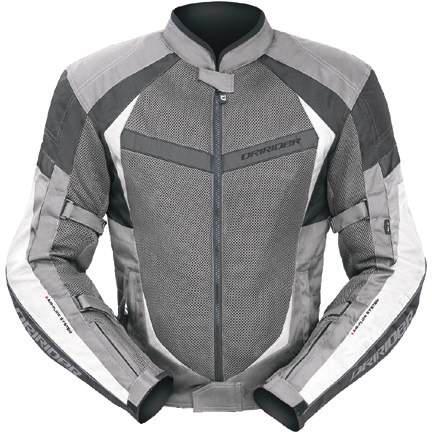
The weather is probably the biggest consideration before mounting your adventure bike and heading out to unwind. This will be closely followed by what you’re going to wear, and to that end, the type of riding suit you’ll choose.
For any rider, selecting the right suit can be a real can of worms, so let’s look at the main considerations for adventure-riding suits:
R The time of year
R The type of riding and speed
R The length of time you’ll be away What about the cost of the suit, you might ask? It’s a major consideration, but if you consider the cost of the suit above these points, you’ll have to make some serious compromises in terms of rider comfort. You might save in the back pocket, but you may well regret it when you’re cold, wet, and a long way from home.
As a general rule, if you’re adventure riding in the northern part of Australia you’ll do it in the winter. Trips in the summer are generally more normal in the south of the country.
Having said that, if you’re leaving from a southern state, you can still be in full winter-type conditions, and that’s before you get up north where the temperature can be over 30 degrees in the daytime.
The weather is such an unpredictable element that you pretty much need four-season capabilities from your riding suit – unless you have the option of only riding on days that look like being fine.
Knowing the climate in the areas you’re riding is important, as is the difficulty of the terrain. Are there open roads where you can average higher speeds? Or are the roads and tracks difficult to manoeuvre your bike around at a slower average speed?
A prime consideration is letting heat out of the suit. In slow going, zip vents offer very little from a cooling perspective, so you need a fabric that will let the air flow through it. Open-road riding, where you’re getting along at speeds of 80kph or more, can be a two-fold problem. On the one hand, if it’s cold you need to keep the wind out, but on the flip side, if it’s hot, you need to be
At higher speeds, zipped vents work well, but as soon your speed drops and you’re having to work harder on the bike, keeping cool is more difficult. Suits made from meshtype fabrics – like DriRider’s Air-Ride – let the airflow through and will cool down more effectively, but they’re not windproof at all, and they’re certainly not waterproof.
Whether or not your bike has a windscreen fitted will also have an impact on how much airflow you’re getting, and how much your
Below: Most bike manufacturers also offer their own brands of riding suits. The BMW Rallye series is particularly good.




suit will allow you to cool down. This can be offset on bikes with very effective fairings and windscreens – like BMW’s R1200GSA – by riding in the standing position to allow for improved airflow.
suit will allow you to cool down. This can be offset on bikes with very effective fairings and windscreens – like BMW’s R1200GSA – by riding in the standing position to allow for improved airflow.
How long do you expect to be away on your trip?
How long do you expect to be away on your trip?

If you have the option to plan your ride or multi-day trip and then move it to when you have a guaranteed slot of good weather (a luxury not usually available or wanted by adventure riders), that makes it a lot easier for clothing selection. But if you have set dates, or if you’re going to be out for extended periods of time when you could experience all types of weather conditions, you have to have gear that will cope.
If you have the option to plan your ride or multi-day trip and then move it to when you have a guaranteed slot of good weather (a luxury not usually available or wanted by adventure riders), that makes it a lot easier for clothing selection. But if you have set dates, or if you’re going to be out for extended periods of time when you could experience all types of weather conditions, you have to have gear that will cope.
Above: American company Klim offers a top-of-line suit called ‘Badlands’.
You can make anything work if you need to – I’ve even used garbage bags and duct tape in desperation to stay dry and a little warm.
You can make anything work if you need to – I’ve even used garbage bags and duct tape in desperation to stay dry and a little warm.
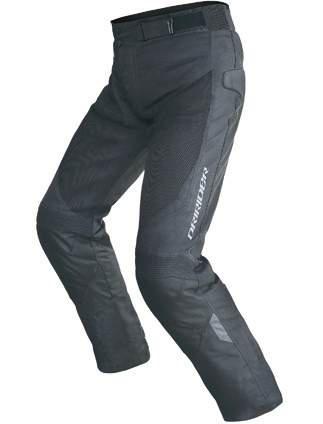
A lot of suits claim they’re 100 per cent waterproof, but water can still find its way in when you’re riding at 100kph. There’s nothing worse than ending up with a wet crotch while you’re riding. Even ‘waterproof’ zips don’t cope with water coming in at 100kph and at different angles.
A lot of suits claim they’re 100 per cent waterproof, but water can still find its way in when you’re riding at 100kph. There’s nothing worse than ending up with a wet crotch while you’re riding. Even ‘waterproof’ zips don’t cope with water coming in at 100kph and at different angles.
The big names in the winter suits are the Klim Badlands, the BMW Rallye Pro 3 range and the Touratech Companero.
The big names in the winter suits are the Klim Badlands, the BMW Rallye Pro 3 range and the Touratech Companero.
It’s worth noting that most suits have comparable protection in case of a crash. The flexibility of some of the smart armours in the more high-end suits make them more comfortable to wear, however, all suits will offer acceptable protection. Some of them will fare a lot better than others after a skid down the road as well – particularly those featuring Cordura.
It’s worth noting that most suits have comparable protection in case of a crash. The flexibility of some of the smart armours in the more high-end suits make them more comfortable to wear, however, all suits will offer acceptable protection. Some of them will fare a lot better than others after a skid down the road as well – particularly those featuring Cordura.
To be able to cope with the cold you’ve got to be able to stop the wind chill and the water on the outside of the suit. If the waterproof and windproof layer is in the suit structure, or inside the suit, you’ll have a lot of wind chill to contend with. And you also have the inconvenience that if you get your suit wet, you’ve got to try and get it dried out. You may have kept your body dry, but your suit will be like an evaporative air-conditioner, taking all your body heat.
To be able to cope with the cold you’ve got to be able to stop the wind chill and the water on the outside of the suit. If the waterproof and windproof layer is in the suit structure, or inside the suit, you’ll have a lot of wind chill to contend with. And you also have the inconvenience that if you get your suit wet, you’ve got to try and get it dried out. You may have kept your body dry, but your suit will be like an evaporative air-conditioner, taking all your body heat.
You need to be able to make your suit completely waterproof. A compromise is to have a one- or two-piece waterproof outer shell, but they’re inconvenient to put on, often requiring you to take off your boots. Another downside is if you don’t get these outer shells on before the rain starts, you lock all the water in and you’ll still get wet.
You need to be able to make your suit completely waterproof. A compromise is to have a one- or two-piece waterproof outer shell, but they’re inconvenient to put on, often requiring you to take off your boots. Another downside is if you don’t get these outer shells on before the rain starts, you lock all the water in and you’ll still get wet.
The outer shells are cheap and pack down quite small, but they have no abrasive resistance and rip very easily, so won’t be any use in an accident.
The outer shells are cheap and pack down quite small, but they have no abrasive resistance and rip very easily, so won’t be any use in an accident.
If you’re doing a day trip and you don’t have a fully waterproof suit, the worst-case scenario is that you’ll be cold and wet that day, but you can dry everything out and warm up when you get home.
If you’re doing a day trip and you don’t have a fully waterproof suit, the worst-case scenario is that you’ll be cold and wet that day, but you can dry everything out and warm up when you get home.
However, if you’re on a multi-day trip, getting your suit dry overnight is often impossible, meaning you’ll be wet the next day as well.
However, if you’re on a multi-day trip, getting your suit dry overnight is often impossible, meaning you’ll be wet the next day as well.
The best of the winter suits have a laminated Gore-Tex in the outer skin. These suits are 100 per cent waterproof and windproof, with overlapped joints, not relying on zips to seal them and keep the wind and water out, while the Gore-Tex offers breathability in all but the hottest conditions.
The best of the winter suits have a laminated Gore-Tex in the outer skin. These suits are 100 per cent waterproof and windproof, with overlapped joints, not relying on zips to seal them and keep the wind and water out, while the Gore-Tex offers breathability in all but the hottest conditions.
A summer suit will work in the spring, and in temperatures down to around 20 degrees, but below that you need to layer up as you have no windbreaking ability in the suit.
A summer suit will work in the spring, and in temperatures down to around 20 degrees, but below that you need to layer up as you have no windbreaking ability in the suit.
A full summer adventure suit is great in dry conditions and at temperatures above 20 degrees, with many options in the market place.
A full summer adventure suit is great in dry conditions and at temperatures above 20 degrees, with many options in the market place.
In extreme heat, hot and slow conditions, the full airflow fabrics are brilliant. Suits using zip vents will work okay at speed, but in temperatures over 30 degrees they’ll get hot and you’ll find it hard to cool down.
In extreme heat, hot and slow conditions, the full airflow fabrics are brilliant. Suits using zip vents will work okay at speed, but in temperatures over 30 degrees they’ll get hot and you’ll find it hard to cool down.
A summer suit has the option of a waterproof outer shell in wet conditions, however, it must be
A summer suit has the option of a waterproof outer shell in wet conditions, however, it must be
remembered that these outer shells do not breathe.
Using your summer suit in cooler conditions is possible by layering up, but layers add bulk, and when you’re not wearing those layers, they need to be stored somewhere on the bike, and that needs to be considered.
Touratech’s Companero is a four-seasons, revolutionary suit designed to work in all weather conditions. It’s basically two suits in one (a summer and a winter), and while it’s the most expensive of all the suits, it does what it says it will do.
Any four-season suit will be heavier than other suits.
The market leaders in summer suits would be DriRider’s Air-Ride and the Touratech Companero in its summer configuration.
So what should you buy?
There are many brands to choose from, including, in no particular order, DriRider, RST, Rukka, KTM, BMW, Triumph, Yamaha, Fox, Klim and Touratech.
If you’re new to adventure riding and a little bit unsure as to what type of adventure riding you’ll end up doing, I would buy something in the $500 to $800 range and get a waterproof outer shell. That will get you by if you are only doing one- or two-day rides.
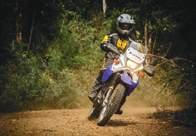


Unless you know that you’re going to be riding in conditions where you will experience all the benefits of a four-seasons suit, then I’d be starting with a slightly compromised approach. That’s certainly what I did.
I’ve had five different riding suits over my adventure riding time, including some roadbike suits, and my suits have evolved as my adventure riding trips have.
You’ll notice that the more money you spend on a suit, the more comfortable it is, and sizing options also improve a lot as you go up towards the high-end adventure suits. You can almost wear a good-fitting suit like a pair of jeans – they’re that comfortable.
Fit is an important consideration, as some riders like a tight fit and some like them loose. Personally, I’d say that the general consensus is that you want a looser fit (which allows for adding layers underneath), and in this regard the sleeve length (neck to wrist with your arm in the riding position) and the inner leg length is very important. You don’t want the sleeves or the legs riding up when you’re sitting on the bike as it’s uncomfortable, and will affect the ability of the suit to do its job.
Your choice should be comparable to your operating window. In other words, if you just need a suit for one-day rides in good weather,
Even in extreme heat, Touratech’s Companero keeps riders comfortable.

your choice is fairly easy. However, if you’re planning longer trips, then your operating window is a lot larger and you’ll need to buy a suit that covers all eventualities.
All in all, do your research, talk to the experts and the suit manufacturers, and buy what’s right for your requirements. While it’s a difficult choice, the more money you spend, the more seasons you’ll cover, and your comfort will increase.
And believe me, you’ll be glad you didn’t compromise on your purchase.





John Hudson and a few hard mates have been out riding the ADVX course in preparation for next year’s behemoth event. He’s found a few things to pass on.
Most riders attempting this across-Australia odyssey will have a fair amount of knowledge and experience. But there are legs in this ride that will be really remote. On the pre-ride we only saw two cars in one set of three days, and there are eight sections, all over 400km, where we saw nothing but camels.
The truth is, very few riders have experience in this environment, so to give them the greatest chance of survival we plan on every rider having a set of track notes that would make an army intelligence officer proud.
For example, the notes will list all other

riders with a similar machine to your own, the spares list in the sweep vehicle and the riders with sat phones so parts can be ordered in the field. Also, all riders will be carrying a SPOT tracker and positions of all riders and the sweep truck will be displayed on a flytrace web page.

Unlike other events, ADVX won’t have regroups, and this is to make things safer. Dust and frustration are the cause of most accidents. By not forcing riders to congregate in one place, a lot of that dangerous situation will be avoided. The negative is that our sweeps may be two days behind the faster riders, and this means everyone must be fully self-sufficient.
The sweep team includes Craig Hartley and myself on bikes sweeping forward of the vehicle carrying Marcel Buys – my race mechanic – and Stuart Woods.

John hudson

These blokes are all hard men that can pretty much fix anything except a rider with a weak attitude.
In this event you need to show up with a go-to attitude. Even loading the bikes we’ll all need to get our hands dirty and help each other out. We all need to take the view that the real challenge is to get everyone across Australia – unless they’re in a hospital bed or their bike is completely rooted.
The way the sweeps will work is Craig Hartley and I will show up first, and if we can get you going we will. If Craig decides it’s terminal we’ll get your gear off that you need to get home and then get the chain off. We’ll have a towing rack on the back of the four-wheel drive that we simply put the front wheel in. When the sweep truck turns up the bike will be put on the truck and the rider in the vehicle. We have capacity for three bikes per leg. After that we tow them behind bikes to the next town.
While the bike is being towed Marcel and Woodsie will get on the sat phone to order any parts needed. If it can be fixed, Marcel will
work on the bike at the night camp.
In a lot of cases riders will be a day ahead of the sweeps, so they may decide to just get towed to the next town. They would then text the sweeps’ phones with the problem and wait for them to call. Riders will need to be aware that the sweep truck will need to always keep moving in daylight hours.
SPOT trackers will be set off for medical emergencies, but if it’s not life-threatening a rider may elect just to camp under a tree for a day and wait for a lift from the truck (that’s why the truck needs to keep moving).
If a rider is really dragging the chain and the
“On the pre-ride we only saw two cars in one set of three days.”

sweeps are getting too far behind, that rider will be asked to take the main road to make up time. If they refuse they’ll be asked to sign out of the event and then they’re on their own – which would be a stupid thing to do.
There are some sections that a few riders may find too difficult.
On the first day of the event we’ll do some sand sections that will test riders’ ability. If riders are dragging the chain on these and dropping their bikes every two minutes, the sweeps will suggest strongly to the rider that it would be unsafe for them to enter some of the harder sections, where there are no options, later in the event. The easy options around them are still great sections, so it’s not the end of the world. The reason we’re offering the alternatives is because we simply can’t carry enough water in the tough sections for riders who don’t have the skill level to get through. We need to get in and out in a certain time frame.
Bike cartage for this event is in shipping containers. To prepare for this you need to do the following:
R Make sure the fuel tank is empty
R Make sure the battery is disconnected
R Write your name on any equipment (because it’ll be stored between your bike and another)
R Put riding gear in ‘Chinese laundry bags’. It’ll be shipped in the container as well
R Bring four tie-downs for your bike and an empty four-litre oil bottle as a fork saver
When you fly to Perth you should simply wear the one set of clothes you plan to wear at night on the ride. The rest goes in the
Top: The sand hills of WA will give riders a taste of the terrain ahead, and let the sweeps advise any riders who might be better off on the firmer cutouts.
Left: Dalhousie thermal springs will be an ideal stop for a freshen up.
container, and we’ll send all the tie-downs back to a shop in each city from which the containers left. No bags will be sent, so the bags you put riding gear into for the trip need to be disposable.
The support truck will only be carrying emergency tyres and won’t part with them unless a tyre has a big hole in it. Most riders will be able to finish this ride on the one set of tyres. An option for tyre changes will be made available in Alice Springs, and riders will need to organise this themselves prior to the event.
In the sweep truck we have one of the best mechanics in the country. He’ll charge a fee of $100 per hour and all parts used will need to be paid for as they’re used.
Many riders in the event will be very busy when they arrive in Alice Springs. They’ll need to get their machine back to 100 per cent before going to watch the prologue of the Finke Desert Race.
On a side note we’ll be organising a refrigerator truck to cart beer and food down to Finke.
An individual is only allowed to buy one

carton of beer in Alice, and we can’t sell beer at Finke because we’ll go to jail. So anyone who wants a drink when down at Finke will meet at a bottle shop in Alice on the Friday evening before scrutineering where we will all get our supplies then put them in the truck which will be parked next to the grog shop. We’ll have a barbecue going the whole time, and it’ll be a help-yourself affair. Just pay as you go. We’ll put up the ADVX flag to show riders where our camp will be.
Once you have a beer at Finke do not go near your bike until the next day.


On the pre-ride we had two riders use their RACQ or NRMA subscriptions to save huge amounts of money on recovery. If you don’t get the top cover before this trip you have rocks in your head. Ken Dark saved $3000 in recovery costs when he had his bike sent home, and they even paid for him to fly to Finke then home. If you have this subscription your bike just needs to be on a public road to be recovered.


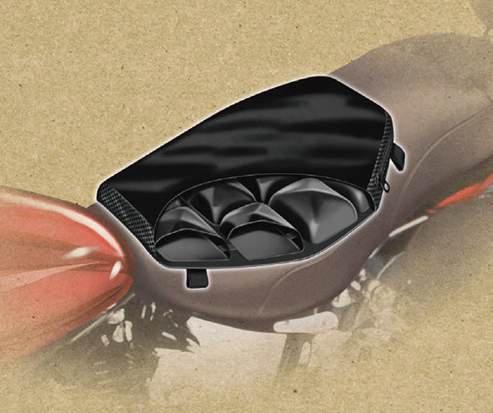


t’s amazing how the use of the brakes can vary so much.
‘Brake feel’ is a term you hear quite a bit, and it’s something a lot of riders started learning on pushbikes way back when. I remember my first bike with a front brake. It could’ve been called an eject button.
But imagine if you didn’t spend a lot of time on a pushy as a young’n. Learning how to ride a motorbike must be quite a daunting prospect. That’s where some good training can make a difference, and ABS can definitely be a very good idea.
Bikes are funny things. Unlike driving a car, it’s up to a rider to separate and blend frontand rear-brake applications. Continually developing, and actively practicing braking skills is the ideal way to make sure your braking and brake feel are at their best.
Watch a learner with four fingers over the brake lever navigating somewhere to park can be scary. You’d swear they were about to tuck the front or pop a fork seal.
It’s about relaxing and learning how to precisely squeeze the brake, rather than just grabbing it. Brake feel is so important, and doesn’t take long to learn if you know how and put in a bit of practice.
One or two fingers will do thanks
Your brake lever is a precise instrument, especially on a modern bike. Two fingers is enough for most applications, usually the index- and middle-fingers. Maybe even just the index finger if you have strong hands and good brakes. You want your thumb and two little fingers wrapped around the bar to keep you connected to the bike, especially if the ground is rough. Four fingers on the lever means only your thumb connecting you to the bike, and that isn’t ideal.
With one or two fingers you can be precise with your application, not a grabber. It seems strange if you were taught to have all four fingers on your controls when you got your
licence, but don’t worry, that’s just to get your licence. Now you’re learning how to ride. Also, same goes for your left hand, you only need one or two fingers on the clutch.
Front? Rear? Both?
The front brake is clearly the most effective at slowing a bike down on a grippy surface. But on a slick surface it’s the brake that can bring you down in a hurry. I think it’s a great idea to always use front and back together, and just vary the ratio depending on grip level, how relaxed you’re riding and so forth.
One exception is sand, where it’s best to not use the front brake too
Right: Getting the brake pedal at the right height can be tricky. It’s different for seated and standing positions.
Below: Using only two fingers on the brake and clutch allows the thumb and remaining two fingers to keep firm control of the bike.
much or very hard. Throttling off and downshifting acts as a great brake in deep sand. For more urgent situations, leaning back slightly and jumping on the rear brake is a good option. It reduces speed quickly and doesn’t throw weight to the front, and that’s best avoided in deep sand.
If your levers aren’t set up well, you’re behind the eight ball before you start.
Make sure your two braking fingers (and clutch fingers for that matter) contact the lever closer to the long end of the lever. Otherwise it’s not really a lever, is it? On most bikes you’ll want to slide the brake and clutch perch inwards between five millimetres and 15mm. The rear brake is a bit more complicated because the ideal position varies between the seated and standing position. When seated the pedal needs to be lower than your footpeg, and for standing it needs to be almost level. Try it somewhere



Getting off-road and learning the basics is a great way to improve.
Keep your speed down. The lack of traction on wet grass can take you by surprise. At least it’s a soft landing.
in between so you can access it nicely from both positions.
The best way to know what your brakes do is jump on them and see what happens, right?

Getting off-road and learning the basics is a great way to improve. Fairly flat and smooth grass is good, and dirt and gravel are fine too. Ride along in the standing position (see issue #01), in first gear at a fairly slow pace, at around 10kph to 15kph to start with. First pull in the clutch so you don’t stall, then apply some solid rear brake and lock the rear wheel. Depending on the grip level the bike may stop quickly. If you’re on wet grass it may slide along for a while. Find the right amount of foot pressure required to get it to lock. If you have ABS you’ll need to deactivate it to do this.
The back end may move side-to-side depending on the surface and any steering input you give. Try to hold the lockup until you come to a complete stop, then release the brake and take off again without putting your foot down by timing the clutch release. Try not to stall or wheelspin to develop maximum throttle and clutch control. Build the speed gradually, through second gear and maybe up
“Learning how to precisely squeeze the brake, rather than just grabbing it.”
to 30kph, and then you can try a little steering input to get the tail to wag.
This is a great way to learn how to control a rear brake skid and get comfortable with the bike moving around. Remember you can release the rear brake to get the bike to track straight again.
Be careful not to go too quick too soon as the back can really slide and catch you out.
The front brake is a lot less predictable when it locks up, so approach front
brake drills with caution.
Just cruise along in the seated position at walking pace, first pull in the clutch so you don’t stall, then squeeze (not grab!) the front-brake lever until you stop. You can keep one or both feet off the ’pegs ready to put on the ground when you stop.
See how much grip there is, feel what the front tyre did, then do it again. The aim is to get the front wheel to lock as you come to a stop, not as soon as you squeeze the lever.
If and when you lock up the front wheel you’ll notice the steering goes a bit odd and the bike will start to lose stability. Release the brake and the steering will come back and the bike will regain stability.
Knowing when to release front-brake pressure is an important instinct you need to understand and develop.
This is when things start getting a bit weird, and it’s not for everyone.
The basic idea is to ride along in the standing position as slow as first gear –
clutch-out – will allow without stalling. Lean back slightly so your weight is biased to the rear. While you have a small amount of throttle you need to gradually add some front brake and gently add throttle to maintain the consistent speed, just above the stall zone. As you add front brake, the front tyre may start to skid slightly or lock. As you feel the steering go vague release or modulate the front brake to get the front wheel to turn to maintain stability.
The ultimate goal is to have the front wheel partially skid but still be slightly turning for a metre or maybe two. The slight skid means you’re close to the threshold, and the partially turning wheel means you still have some steering control.
The reason for practicing this skill is not because it’s an actual riding technique. It simply helps you understand how to react in a front wheel lock-up situation.
R Don’t try this too fast, if the front wheel locks and you don’t react, you’ll fall
R Look ahead. You need forward vision to maintain balance
R Cover your clutch. Adding front brake may cause the engine to stall. Allow a small amount of clutch slip to ensure the bike doesn’t stall
R Don’t over rev and slip the clutch heavily at the same time. This is not good for your bike
R Try not to accelerate. It’s not about pushing throttle against brake and gaining speed. Try to keep the speed very consistent
R If you don’t position your weight to the rear the exercise is much harder. You may find that the front tyre grips and you actually get wheel spin instead
It is not always obvious to lessexperienced riders, but in most cornering situations an advanced rider can use their front brake right into the apex of a corner. The key here is the amount of brake
pressure changes as the bike goes from vertical, where you can brake hard, and reduces gradually as the bike starts to lean into the corner, to the point where the bike hits the apex, the brake is 100 per cent released and the throttle opening begins.
Trail braking doesn’t come naturally to less-experienced riders. Novices tend to brake moderately while upright, release the brakes almost as soon as the bike starts leaning, carry minimal corner speed and coast into the apex of the corner. There is nothing wrong with this, but it’s a slower way to link corners together.
When it comes to road and adventure bikes, ABS is the future. I’ve been using ABS on a variety of bikes for over 10 years and these are some things I’ve noticed:
R The biggest knockers of ABS have not used it much or at all
R More riders are understanding and embracing ABS
R ABS technology is always improving
R Some new systems are designed with an off-road mode, and work amazingly well in the dirt
R ABS systems that can be easily adjusted or deactivated really give the rider all options
R It’s not good advice to tell a rider “turn ABS off as soon as you go off-road”. Understand how ABS feels off-road before you turn it off
R All riders benefit from rider training and developing a high level of braking skills and feel, regardless of ABS. Turning the ABS off and practicing brake drills keeps a rider sharp and respectful of their brakes
So get out there, practice some skids and tune up those braking skills. The sharper you get, the better your riding experience can be. But remember, you don’t get better if you don’t put in a bit of time.























At least we hope so.
He’s about to set off and chase the Byron Bay to Steep Point across-Australia record.
The record’s something like 92 hours to cover around 5000km. It’d be tough under any circumstances, but trying to cut straight through the centre of Australia? Across the Simpson Desert? That’s going
to take some serious commitment.
If there’s one thing Scott’s not short of, it’s commitment.
With the guys at Crossroads Motorcycles in Grafton, NSW, looking over his shoulder and shaping the attempt, here’s the bike Scotty’s chosen.
Hold on to your hats, people. This is very serious.
The bike is a KTM 690RFR.
For those not used to tracking around in


the sparsely populated upper echelons of the world rallye circuit, that’s a purpose-built KTM rallye special. There are eight in Australia that Scott could find, and the bike you see here was owned by Rob Pollard, ordered to compete in Dakar. After a successful run in the big race – and an Australasian Safari – the bike was immaculately maintained and now Scott is setting it up for this latest challenge.
The connection with Crossroads Motorcycles in Grafton might seem odd for a bloke based south of Sydney, but what few people know is that the owner of Crossroads is Lee Palmer, an ex-KTM Factory Team mechanic who was involved in the design of the RFR, and who’s worked for the KTM Factory team out of Austria, on and off, for the last 15 years or so.
Ah.
Now it all begins to make sense.
The whole Byron-Bay-to-SteepPoint crusade isn’t new.
Without us doing a whole heap of research and verification, our unreliable memories have Tony Kirby starting the whole thing when he set out to prove the reliability

A rare beast. The KTM690RFR is a special-order only bike. There are eight in Australia.

of Yamaha’s WRF400 late last century. TK and his mate Don Cant did it in about four-and-ahalf days, or 108 hours or so.
Since then Motorbikin’ main man Phil Hodgens has had a couple of cracks at it, and managed the crossing in 92 hours, give or take.
“I guess I was motivated by the Motorbikin’ crew,” explained Scott, “and the two journalists who did it years ago.”
Scott raced enduro in Victoria as a youngster, and now says he’s keen to test himself, and has therefore set this crossing attempt up as a solo venture. We know there’s been some discussion about the different routes used in the past, and how they should be taken into account when considering a ‘record’, so we asked Scott what he thought about that.
“The key point for me is to stay as close to a geographic straight line as possible, within reason, staying on publicly accessible roads,” he latituded. “That means basically from Byron to Birdsville, straight across The Simpson, past Uluru, down The Great Central Highway to catch The Old Gunbarrel Highway, through Wiluna, across to Meekatharra and on to Steep Point.”
Purpose-built
The demands Scott’s going to make on his mind and body are a whole story in themselves, but for now we’re interested in the bike he’s building. It’s one exotic mutha, and they’re not easy to find.
“KTM only produce the RFR for people on special order, generally for Dakar,” 690ed Scott.


“After an attempt last year on a 640 Adventure that went wrong not far from the finish, I searched long and hard. I was at the finish of the Australasian Safari and I mentioned what I was doing to some bike friends from WA and they put the feelers out. I hit up four of the eight owners in Australia and found one who was in a position to sell.”
That made for a good start to the adventure.
The 690RFR holds 37 litres of fuel, and that’ll give a range of about 550km. It won’t be enough to do a couple of sections of the crossing, so Scott has organised to drop fuel at strategic locations. Not only fuel, but tyres as well…complete wheel sets, actually.
“I have a fuel cache out in The Simpson, and then between Warburton and Wiluna, which is an 820km stretch,” he octaned. “I’ve also got complete wheel sets sitting at Birdsville and
Left: It’s a very tidy-looking outfit with a 37-litre fuel capacity giving a range of something like 550km. Below left: Love that sexy hardware!
Right: The cockpit has been modified to give the comms and tech data needed.
on the other side of The Simpson. That’ll help reduce downtime for changing tyres.”
Mitas is Scott’s choice for rubber, and he’s running E07s for the majority of the tar out to Birdsville, and then swapping to the mega-tough E09s for the rest of the trip. The tyres will run with ultra-heavy-duty tubes and they’re installed with heaps of talcum powder to reduce possible chafing and to cope with the heat of prolonged high-speed running. The tyres will also run nitrogen instead of air. Nitrogen reacts far less to temperature change than normal air.
The link with Crossroads Motorcycles in Grafton came about when the previous owner of the bike had Lee Palmer’s number and suggested Scott give Lee a call.
“I contacted Lee and he was naturally interested because of the bike I’d chosen,” said Scott. “He thought it was a good venture and wanted to get behind it.”

Lee was the one who organised the sponsorship with Mitas tyres, RK Chains and Motul oils, and his commitment goes way beyond mechanical work and lining up sponsors. He plans to jump on his own 690 Rallye and head out into the desert to await Scott’s arrival and offer any tech help needed – and raid parts off his own bike if needed.
That’s a pretty good guy to have on side.
To try and make the target time there’ll have to be some long hours spent riding, and plenty of those will be after sunset and before sunrise. Scott did his research before fitting up an impressive lighting rig.
“Any KTM690 has a stator that pushes out about 260 watts,” he illuminated, “and I’ll use about 170 watts if I use all the lighting at once. That safely leaves me enough to run everything else and still have the battery looked after.”
The set-up replaces the standard 60mm halogen units with two Hella 90mm Bi-Xenon dual high-low-beam units. There’s also a pair

of Baja Designs LEDs bracketed to the forks to provide effective light in close and to the sides where “the ’roos can disappear out of your headlight beam just prior to impact.”
Gulp.
There’s been a lot of thought gone into nav and communications gear as well. All the technical equipment has been mounted to a custom-made nav tower and includes a Starcom unit, phone, UHF and tablet hardwired to Scott’s helmet. Hardwiring was used so there’d be no need to recharge Bluetooth gear.
Scott’s crossing will be plotted on a SPOT tracker, so everyone watching will be able to see how he’s doing and check his time. But he’ll also carry a more advanced set-up. Safety and tracking equipment has a high priority.
“I have a HitAir jacket that’s tethered to the handlebars. If I’m thrown from the seat, the jacket inflates a protective air cell that supports the neck, entire spine and lumbar

areas. This thing deploys in less than 0.25 of a second, which is generally prior to impact.
“The tracking unit is also tethered to me. So if I’m thrown from the seat, it automatically sends an alert after 30 seconds. That allows time to cancel the alert if it’s unnecessary. There are two key characteristics to this unit. It’ll only notify the contacts programmed into the unit – meaning emergency services aren’t unnecessarily activated – and, as far as I know, no other unit can be programmed to automatically alert if the rider is unconscious or incapacitated.”
At this stage, depending on weather and some other variable factors, Scott’s aiming at making the attempt in August sometime. Keep an eye on www.advridermag.com.au for details and to watch Scott’s progress as it happens.
It’s a huge challenge, and this bike is a work of art.
But that’s not enough for this rider. If he makes the crossing in 80 hours, he then plans to turn around and ride back to log a double-crossing time for others to aim at.




It’s a holiday on a disc.



Nobody wants to miss this one.

Who even knew these little campgrounds and picnic stops existed?

With a week in hand, a couple of great bikes and all the goodwill in the world, the Adventure Rider Magazine crew couldn’t decide where they should spend a very precious few days riding. Nobody had time to plan a route or check out accom, let alone work out fuel stops and whether or not roads and trails were suitable.
As everyone sat around hoping someone else would organise something, the publisher, wearing a triumphant expression, charged into the tea room, almost causing everyone to look away from the telly. As everyone dragged their swollen, teary eyes from The Bold And The Beautiful he announced, “I’ve got us covered,” and with a flourish produced what looked like a DVD.
Everyone cheered up instantly.
“This disc has everything,” he KTMed. “There’s 2000km of riding between Moonan Flat west of Taree and Woodenbong on the NSW/Queensland border.
“And it’s all suitable for big blokes on big bikes…like us!” he high-beamed.
When he’d opened the disc, not only were the rides laid out complete with descriptions and photographs of what to expect, but every section was supplied with distances, approximate riding times and –wait for it – route sheets and GPX files ready to drop straight onto a Garmin GPS. How good was that!
It meant everyone – well…the editor anyway – could work right up until it was time to climb on the bikes. All the planning and research had been done.
After cunningly telling everyone at the office they were heading out to ‘do a story’, the AdvRider Mag crew teamed up with some likely Sydney blokes and headed off to see just what the disc had to offer.

The idea is to stop and enjoy the lookouts and other landmarks, as well as the superb riding.
The weather was perfect, the company good, and it turned out the disc offered everything this mixed collection was hoping for.
The guys on the big bikes loved the long, long dirt roads and incredible variety of scenery, the mag staffers loved being out of the office, and everyone loved the ‘track notes’ printed from the DualSport Australia disc. The distances between fuel stops were accurate, the assessment of the difficulty of each loop was spot on, and the riding times were…close. The times really depended on which loop the team chose.
The disc is laid out with ‘east’ and ‘west’ loops. The east loops are mostly easier and more cruisey than the west loops, and recommended in wet weather.
The AdvRider Mag team decided it was all gung-ho and should tackle the west loops going north, then come back on the east loops. The loops intersect at the main towns, and that was a great idea. It’s easy to chop and change as the day unfolds.
After some lengthy coffee and snack stops, the loop times on the western runs stretched out a fair bit. Even without stopping at the landmarks and points of interest in the track notes the crew still went well over the predicted time. The eastern loops were much faster and the predicted times much closer.
Bearing in mind this was five days of work for the magazine team – so there was no goofing off allowed. Everyone had to try as hard as they could to enjoy themselves –concentration was kept at high levels. But it was impossible not to notice the dirt roads winding through subtropical forests, the lookouts, the forestry huts, bridges running low over crystal-clear rivers, and even the country pubs and cafés in the sleepy towns. The accommodation and fuel-stop notes were spot on, and in general, the DualSport Australia disc offered the comprehensive ground work which should’ve been done, but that the group simply didn’t have time for.
Of course, none of the riders had an intimate knowledge of the region, so they’d have had little chance of finding the routes even if they’d been looking. All the riders had to do was punch the selected route into the GPS, check the track notes, and hit the trail.
Even those who weren’t up with GPS technology could print the route sheets and run them on a ’bar-mounted map roller or display them in the top of a tank bag.
It has to be the best thing to happen to adventure bikes since the heated grip.


AdvRider Mag really reckoned this is a well thought-out and superbly researched piece of work. If you’d like to grab yourself a copy log on to www.advridermag.com.au/store.




y husband is one lucky man. I hasten to add that it’s not because he’s married to me (although that’s surely got to be up there). As an adventure-riding husband with an adventure-riding wife, he’s at a distinct advantage over all those riders out there whose partners don’t, or can’t, ride. I’ve come to this realisation after chatting with quite a few married or otherwisepartnered blokes. For those riders, having time to ride doesn’t only depend on work/family/money. It also requires the accumulation of ‘brownie points’. These men are busily mowing lawns, repairing doors, cleaning gutters, fixing fences and a myriad of other jobs, all so they can be ‘allowed’ to go for a ride. I’ve never actually asked if certain jobs have designated point values. Or if the longer the ride, the more points need to be stockpiled. Or if the points are transferrable to a friend. The only certainty is that for these adventure-riding enthusiasts, jobs around the house equal riding time.
This is all fine for riders whose partners don’t ride. However, when you both ride, no-one needs to rack up brownie points. This is why my husband is lucky. He must be one of the few blokes who rarely suffers a knockback. Whichever of us suggests a ride, the other is usually more than willing to leave whatever important job they’re doing and go. That probably explains how we manage to work full time and ride tens of thousands of kilometres in a year. However, it means all those little jobs around the place tend to get put off. It also means that it’s an adventure ride just to find our way through the long grass at the front gate and through the bog holes and ruts in the driveway made by water spilling over blocked gutters. Neither of us is going to say, “If I clean the windows how about we go for a ride this afternoon?” One of us is more likely to say “we’re awake, let’s go for a ride.” I always think that if one of us didn’t ride, we’d have the most organised and wellrepaired place around.
The kids get a bit tired of all our riding. I guess I can understand it to some extent. It must be tough when your loving parents leave you for the weekend with only a list of jobs and a fresh loaf of bread to tide you over. I like to think we’re
teaching them to be resilient. (I know they’ve become resourceful. They’ve worked out the exact shade of tea to refill the rum back to the mark I’ve got on the bottle.)
So I feel I should let out a little secret held by the collectors of the brownie points: the truth is, most of these partners are quite happy for the men (or women) in their lives to go riding with their mates every now and then. Just ask a few of them. There wouldn’t be too many who don’t relish the thought of an entire weekend – or week – choosing what they want to watch on the TV without someone endlessly flicking channels, not having to cook meat-and-three-veg, having the bed to themselves and chatting endlessly to friends or their mother on the phone. As much as wives, girlfriends (or otherwise), partners love their adventure riders, a bit of time without them can be quite welcome from time to time. That a whole heap of essential jobs get done too is, quite simply, a very nice bonus.
Contrary to what a few people have claimed, I’m happy for Dave to go riding without me (on the odd occasion). In fact, I’ve actively encouraged him to go on a few of these rides without me. Instead of gathering brownie points by doing jobs, I see his trips as a way of balancing rides I do without him.
I really enjoy that our son rides with us every now and then. At least at those times I know

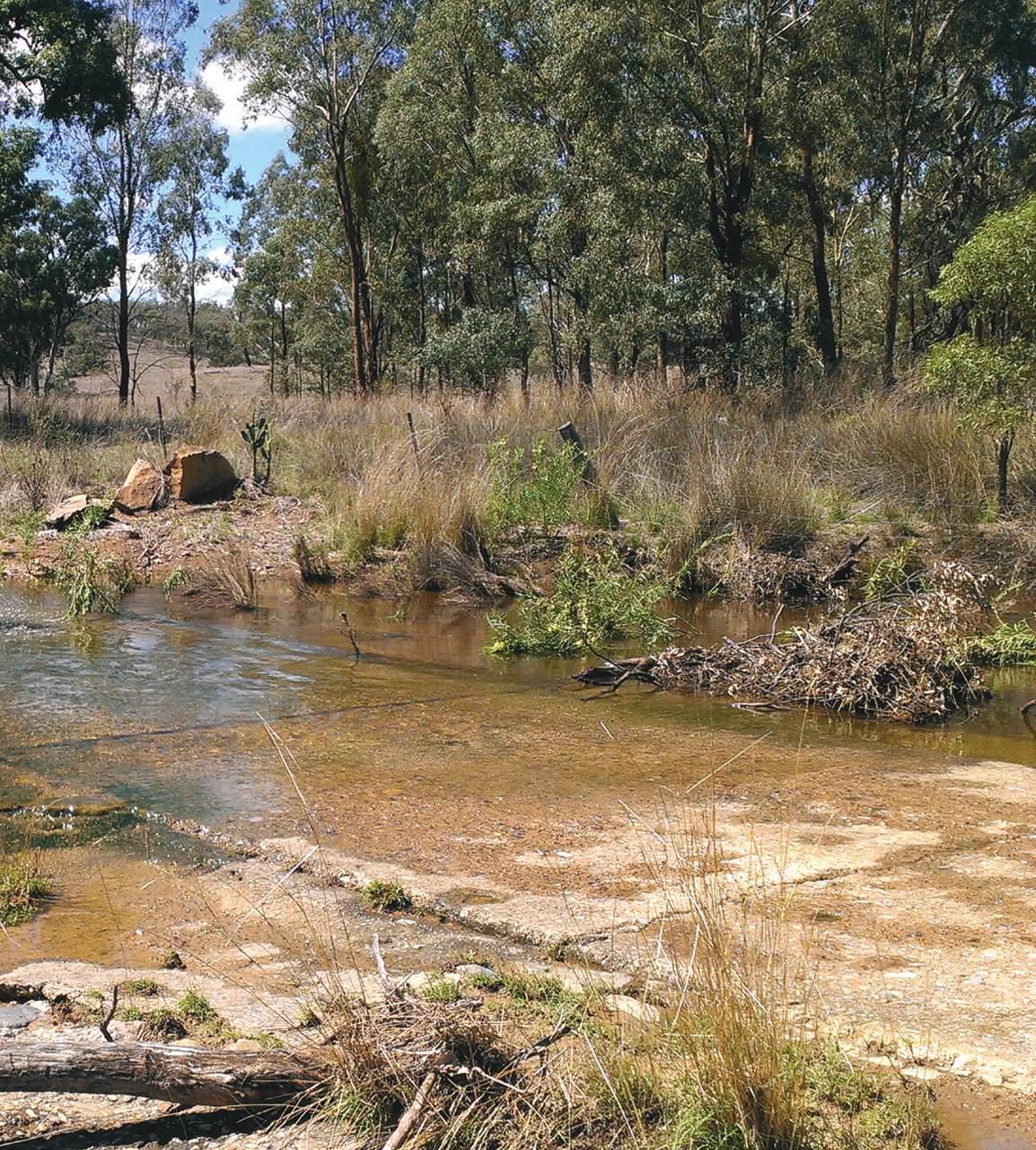
where he is and what he’s doing. I still worry about him…especially when he takes off with some of the hard-core riders. Then again, I worry about him driving, playing footy, and going to the pictures with a girl. I guess that’s a mum thing.
As yet, he hasn’t gone off riding on his own or with his mates, so he hasn’t needed to store brownie points at home. So I still don’t have someone to do all those little chores around the house for me.
Next year I think it might be time for me to do a big trip. I’m not too sure where or what yet. I’ve got a few ideas and options in mind, but I’m open to suggestions. One thing’s for sure though: if I make it a solo adventure, I’ll be very quickly learning how to sand decks and concrete the driveway.
And if Dave and I go together, I think we’ll either have to bribe our kids or hire some substitute, non-riding parents.

Below: When both partners ride, no-one has to earn brownie points. And one of you can be in the photos.

v I’d rather have an adventure-riding partner than non-dripping taps
v Actually, I’d love both!
v If it’s possible for your partner to ride, do everything you can to encourage and nurture them
v Any day is a good day for a ride
v A teabag steeped in 460ml of hot water for seven minutes makes a brew the exact shade of UP rum

The Tasmanian Adventure Riders Hub Facebook group staged the first leg of its inaugural Tasmanian Adventure Safari in May. Andrew Brodribb tagged along to keep an eye on things.

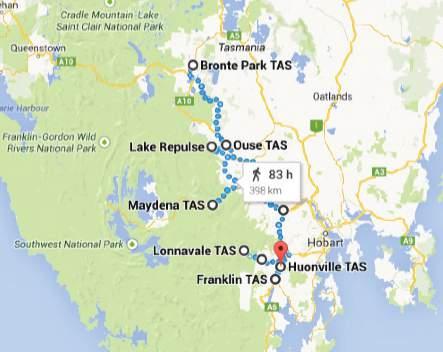




The 2014 Southern Safari started at Huonville, Southern Tasmania. A dozen riders fronted up for an early start, with rider experience ranging from decades through to eight weeks on a Learner’s permit, and the ride was planned to suit big 1200cc adventure bikes, all rider abilities and bikes with road tyres.
The group travelled south to Franklin where the bitumen was left behind. Riders rode winding forestry roads through the scenic Huon Valley, crossing the renowned Huon River, passing through Lonnavale and Judbury, then crossing into the Plenty Valley. The smooth gravel roads led through towering gums, past massive man ferns, beneath majestic mountains and showcased spectacular Tassie scenery. The route also took in a couple of optional off-road, single-track challenges and a creek crossing – which proved routine until Corné Kloppers decided to show some of the lessexperienced riders how to do it. This guaranteed entertainment for the audience and an impromptu swim for Corné.
After passing through the Styx Valley with some of Tasmania’s biggest trees, lunch was at the forestry town of Maydena, followed by a scenic hill climb to almost 1000m above sea level. Riding through more tall trees in the Florentine Valley to Lake Repulse saw a couple of riders peel off and head home. The rest of the group rode on for a night at the Tarraleah Lodge, a hydro-era highland village. We were lodged in three art deco cottages – budget priced at just $80 per person, but still luxurious – and dinner and drinks at The Highlander pub saw us gorging on an all-you-can-eat gourmet barbecue.
How does three steaks for dinner sound?
Sunday saw a later start with the group riding through one of the earliest areas of Tasmania’s hydro-electric scheme, passing large wooden pipes still in use at Laughing Jack Lagoon, then onwards towards Bronte Park. The group then headed east for home, travelling through some amazing winding roads, passing world-class trout fishing lakes in the Victoria Valley. From there it was on to Ouse, Hamilton and New Norfolk, where beers at one of Australia’s oldest pubs, the Bush Inn, signalled the end of the ride.
The ride was able to take in just a small sample of some of the best Tassie has to offer the adventure rider.
Different legs of the ride were led by Andrew Brodribb, Chris Wharmby, Daniel Butterworth and Corné Kloppers. The corner marker system was used and ensured the ride flowed smoothly. There was always a helping hand nearby if needed. We even had a support ute that followed the route and was able to provide the photos you see here – thanks to the crew, Anne and Shane Bell and Katie Brodribb.







Top: Greg Faure’s bike was Terrafied. Sequence above: Corné came a klopper hoping to show the novices how to handle a crossing. No harm done and smiles all ’round.
The Tasmanian Adventure Riders’ Hub Want to know more about the Tassie guys? Log on to the Facebook page.












Words: Craig Hartley. Images: Kaine Riley

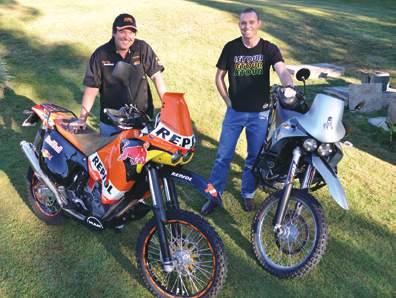
Probably, the best singlecylinder production bike ever built? Craig Hartley thinks so.
The first KTM 640 Adventure was released in Australia in 1998 and ran as a solid, single-cylinder adventure alternative right through to 2007. The 640 Adventure’s life began from the massive reputation KTM earned in prior years running the KTM 640 Rallye and then the KTM 660 Rallye in the Paris-Dakar Rally.
Many components of the KTM 640 Adventure came straight off of the 660 Rallye and actually do interchange – the rear subframe, the fairing, the 28-litre
tank, as well as most of the engine components, for instance.
KTM hit the nail on the head with the perfect package on the first 640 Adventure, just as it did with the first 2003 KTM 950 Adventure. The fairing and cockpit area works well to keep the rider protected from the elements and was finished off with excellent build quality for strength and long-life endurance. You could even buy a bracket

to mount a map reader above the trick digital rallye-like speedo.
The fuel tank is built of nylon and, showing how close the bike was to its Rallye cousin, could be interchanged with the 28-litre plastic fuel tank off the Rallye bike. The main fuel load was carried low for better weight distribution and handling.
The rear subframe is a strong, chrome-moly steel item that would easily support the loads an adventure rider would want to carry on both the carrier and saddlebag racks.
The design of the seat was large enough and comfortable enough with enough foam for long-distance hauls.
KTM didn’t leave out important handling characteristics, either. The high-quality, long-travel White Power shock and forks worked really well straight out of the box. In later models the addition of heavy fork springs was all that was needed for the perfect package.
KTM fitted a well-designed rear carrier that would easily take a swag or top bag, and doubled as good grab rails if needed, and a genuine aluminium bashplate was also fitted. And it didn’t need to be upgraded like the bashplates on many production bikes.
Even a centrestand was fitted to complement the side stand.
The 320mm, single-disc Brembo front brakes were more than up to the task of pulling the bike up in all situations, and this was complemented by a single Brembo rear disc. A quality, high-front mudguard was also fitted standard to the earlier models from 1998 to 2004.
In the last of the model range KTM opted to fit twin discs and a low front guard. Even though it looked good, it was just additional unsprung weight and not a big advantage to the overall braking. Still, the overall weight of the bike was a very handsome 158kg, and that fits right in the weight range hard-core adventure riders all over the world consider as optimum.


Over the years KTM did do some upgrades that were worthwhile.
The conventional White Power forks went

to upside-downers – still White Power – and in the early 2000s the LC4 motor design was upgraded slightly with a high-flow head and extra oil lines for better lubrication of engine components. These changes had already been implemented on other bikes using the LC4 engine.
There was also a different ignition system used to cater for low-octane fuel, and then the twin-disc front-end appeared on the last couple of models. But apart from minor dashboard instrumentation changes the bike remained basically the same for 10 years of sales.
For a couple of years after the KTM 640 Adventure was no more, the rumour mill ran hot with stories of a KTM 690 Adventure. The 640 Adventure had emerged from the u


design of the KTM 660 factory Rallye bike, so people all over the world were hoping for a KTM 690 Adventure designed along the lines of the last of the 690 Rallyes. This dream never came true, and it was the prompt that drove us to offer the Australian-designed HARD KTM700RR Adventure.
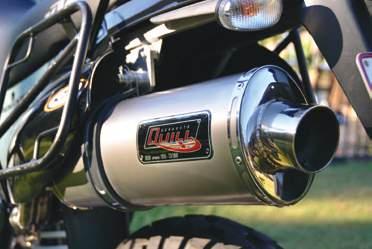

Due to the 640 Adventure being such a well-finished package, not a lot of things had to be done to make it a hard-core, long-distance adventure weapon. On a wet muddy road at night between St George and Mitchell in 1998, and on the very bike now owned by Darren Wilson in the photo spread, I found that by holding the high/ low-beam switch in the halfway position I had the benefit of the long-distance spotlight high beam and the bright gutter-to-gutter spread of the low beam. Once home we ran a relay so both the high and low beams were on together when high beam was selected. This is something I’ve done with many adventure bikes since (and is how the 700RR is wired).
On later models with the twostage ignition, a switch should be fitted to eliminate detonating with bad fuel that could cause major engine damage if ridden at high speed in the wrong mode. Either that or disconnect the wire
Above right: The last 640 Adventure featured a twin-disc front end, low front guard and a sexy paint job, but those didn’t necessarily make it a better bike than earlier models.

to activate that ignition in bad-fuel areas.
As was mentioned earlier, many bikes suffer from soft fork springs, and the later models with the upside-down forks were no exception. Heavier springs will make the bike handle better and feel more stable in all situations for almost all riders.
All of the normal things like high ’bars or ’bar risers, heated grips, lighter and cooler mufflers, pannier racks, folding mirrors, decent tyres and ultra-heavy-duty tubes, sidestand plates and GPS can all be fitted to personalise the bike for your situation, but at least with the 640 Adventure, you don’t have to worry about a lot of things – like trying to get some power out of it, extra-large fuel tanks, carriers and a stack of other accessory gear, because it’s all fitted standard.
For the absolute do-it-yourself enthusiast, the sky is the limit with the KTM 640 Adventure. You can see that with Darren Wilson’s pride-and-joy.
This bike was owned by myself and was literally the first KTM 640 Adventure to come into Australia in 1998 for the KTM conference held at the Gold Coast. After much talking
over late-night drinks I convinced Jeff Leisk to let me take it from the conference and straight out on a ride the following week. The bike performed absolutely faultlessly and was the envy of all others on the trip.
Back to the do-it-yourself bit. As Darren has done, a low pipe and bashplate can be built.
Darren designed direct from my 1999 660 Rallye, and he’s fitted the rear fuel tanks from the same bike. There you have it: basically a 660 Rallye replica built from a 1998 KTM 640 Adventure.
The beautiful 2003 silver 640 Adventure shown in the photos is owned by Kaine Riley from the Gold Coast.
Kaine purchased the bike for $5500 with only 33,000km on the odo. This one had been used for mainly bitumen work and had accessories that included a spare set of tyres, a form of pannier rack which has been replaced with Dalby Moto saddlebag racks, and a set of tank crash bars, widened footpegs, Touratech chainguard and sprocket guard, slip-on muffler, fork bleeders, driving lights and 30mm ’bar risers. Apart from the new saddlebag racks, Kaine will be fitting a new set of heavy fork springs as well as a set of highrise Pastrana FMX ’bars. With these small additions all Kaine has left to do is put his Andy Strapz bags on and head to the horizon.
A big thanks to Kaine and Darren for the use of their bikes for the photos.
In some riders’ eyes the KTM 640 Adventure has been known as a bit of a vibrator, but this varies from bike to bike and person to person.
First, vibrations are never noticed as much on dirt and gravel roads as on bitumen, and these bikes are designed for off-road. Second – and this may only be my theory –but I believe different people have different tolerances to vibration, just as different people have different tolerances to wind buffeting. By this I mean some people get on a bike and say,

“Wow! It vibrates a lot!” Other people will jump on and say they can’t notice any vibration at all. Different folks equals different strokes.
Having said this, if vibration on any bike does worry you there are fixes. I’ve seen some people put weights on the end of the ’bars just like the old GSX 1100 Suzukis, and then there are different ’bar mounting systems like the KTM PHDS (Progressive Handlebar Dampening System) that can be fitted to take vibration and shock out of the ’bars. The new Scott steering damper mount also comes with neoprene antivibration and shock mounts.
I’ve seen some 640s with a comfortable 70,000km on them and still untouched in the motor department, and I’ve heard of some bikes with around 100,000km on the clock. Having said that, I know a few people who have killed them at 35,000km. It really all boils down to having the right gearing, having a bit of respect for the motor, and regular oil changes and servicing. There’s no guarantee to cover how long a motor will last, but we do know the overall package is still definitely worth buying for a good adventure-bike.

3 3 Reasons to keep Reasons to keep you on the road... you on the road...
Designed to lock your helmet to your bike. Simply set your own 4 digit code, open the lock, slip the carabiner through your helmet’s D-shackle, attach it to your bike and lock it!


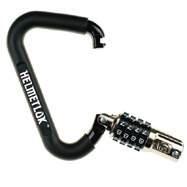
Ultra-compact, weighing in at only 570g, the MotoPressor™ can be used to inflate tyres, top off air shocks, air forks, inflate airbeds or anything else, anywhere, anytime, over and over again.
A puncture repair system for tubeless tyres. Simply remove the object that’s punctured your tyre, insert a plug into the puncture hole and pull the tool out of the tyre. Job’s done!


At 27, Toby Price could rightly feel he stands on the threshold of a stellar international off-road racing career. With a string of national championships behind him, the support of KTM, and, most of all, a huge natural talent for racing dirt bikes, the Maitland rider is as cheerful and happy a rider as any we’ve met, but it wasn’t so long ago a savage neck injury had his career in doubt. Adventure Rider Magazine caught up with him just after he crossed the finish line at Alice Springs to claim his third Finke win.
AdvR: You’ve had some shocker injuries, but the latest one was serious, even by your standards. What happened there?
TP: I don’t remember the accident or hitting the ground, but I was competing in a national round of the Hare And Hound in the US, preparing for Baja. I ended up breaking my neck. I broke the C6, C7 and T1 vertebrae. Now I’ve got eight screws and two bits

“I’ve got eight screws and two bits of rod that go down my spine holding it all together.”
of rod that go down my spine holding it all together.
I’ll always have this injury, but I got very, very lucky. To still be on my feet and walking is a gift. Since the day it happened I’ve put in a lot of hard work and effort to get back to Australia for the surgery, and to do the cycling and rowing and physio and all that stuff to build up the strength in my neck again.
I guess an injury like that might scare a lot of people away, but for me, it makes me stronger. After that injury I’ve come back and won Finke.
AdvR: A good win on the weekend?
TP: Definitely.
It’s good to get that monkey off my back. It shows I can put the neck injury into my past and not worry about it.
Finke’s never easy, and because it only comes around

once a year it makes it hard work. But it all went fairly well. To go down and back in under two hours each way is a good effort. You just have to stay on two wheels, keep the bike straight and do what you can. This year it worked out really well.
Now I can’t wait to get home. It’s a bit under 365 days until Finke next year, and you can never stop planning for this race.
AdvR: Were you able to pre-ride the course?
TP: I did two trips out here before the event, pre-running, testing and doing bits and pieces. The pre-riding went really well. We had good people, like previous multiple winner Steve Greenfield and his GDR suspension, and he helped a lot. We worked hard at it.
AdvR: Was the bike a Factory special?
TP: It was a KTM 500EXC, and it was pretty much as anyone can buy them from the showroom floor. We changed a piston and bearing to cope with those long, hard stretches where the thing’s operating at or near the redline for extended periods, but the change doesn’t alter the compression ratio. It’s a change to cope with that specific type of abuse. The bikes aren’t built to be
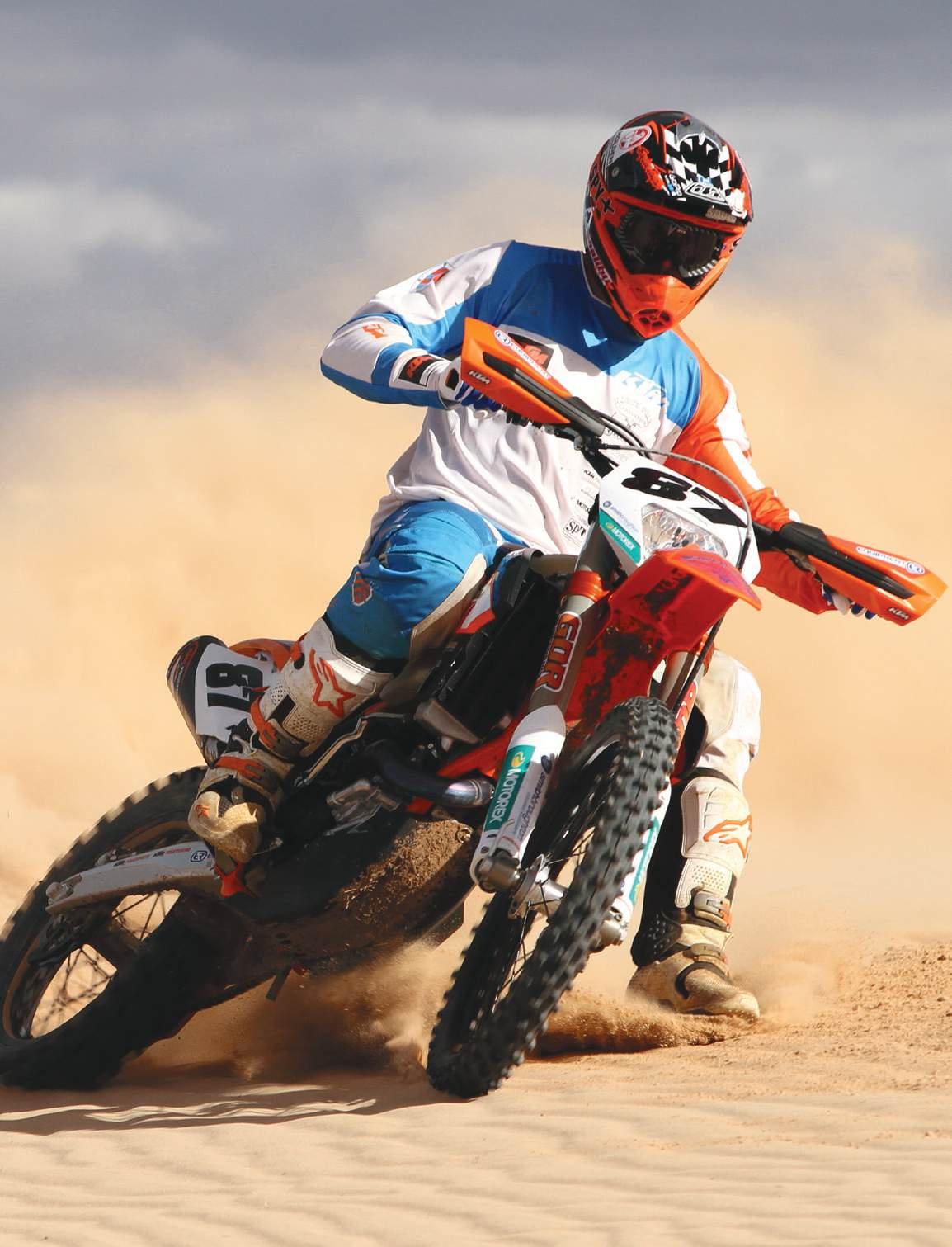

held wide open for minutes at a time and to run at such high temperatures.
We have our add-on bits, of course…a bigger tank and a steering damper, coated forks from the SX bike, a shock, StegPegz. After that we threw some stickers on there for the sponsors, and that was about it.
AdvR: You’ve been racing for a long time. Do you have a trade or profession?
TP: I don’t have a trade.
I’ve been racing pretty much my whole life. I started when I was four years old, and you could probably knock off a couple of years for accumulated injury time, but I’ve always worked hard at, and put a lot of time and effort into, racing dirt bikes.
I’m just determined to do well at dirt-bike racing. I can’t win every race, but it’s what I want to do. Any race I compete in I just do the best I can, but I also want to have fun while I’m doing it.
AdvR: Is rallye racing where you see your future?
TP: Since I’ve joined KTM in 2010 things have pretty much skyrocketed.
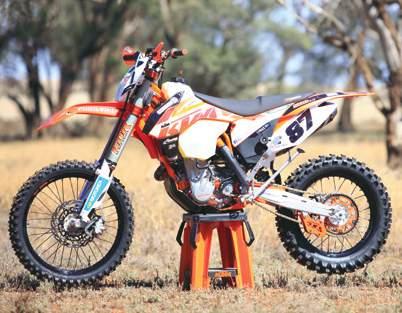
events like Finke means we can try our hand at desert racing and go up against the world’s best riders.
It’s a big effort to try and do a Dakar or any of the world rallye championship rounds. It’s not so much high-speed, dangerous racing. You have to navigate, be consistent and be a smarter rider. We’re working on those things, and if an opportunity comes up we’ll see if we can get into it and get it done.
AdvR: What do you do with your time off?
The KTM set-up is good here in Australia, but it’s good worldwide. It gives you some options to look at racing overseas, and having someone like Jeff (Leisk) who supports
TP: I’m pretty much just like anyone else that likes to go and have a bit of fun. I like surfing, fishing, wakeboarding…all those types of things. I don’t party much, but I like to go out now and then.
AdvR: Is the KTM team environment a happy one?
TP: Yeah, definitely!
I’m in both the enduro team run by Brad Williscroft and Ben Grabham’s desert-racing team.
AdvR: What’s the competition like within the team? Ben Grabham (team owner) is a pretty competitive sort of bloke.
TP: Grabbo and I get along really well. I wouldn’t be doing so well in the Finke if it wasn’t for Grabbo. He doesn’t hold back on sharing information, and if he finds something good that might help me, he’s more than happy to share the find.
All we want to do is see how fast we can go in the desert, and he wants to see me go as fast as I can. It’s a big positive, and it’s great to have someone on board like he is.
AdvR: Is there any likelihood of a Dakar in the near future?
TP: There’s been a little talk. I definitely want to have a go at Dakar, whether it’s next year or in three or four years, I don’t know. I’ve had a few chats with people in Europe and Austria, and with the rallye team, to see what it would take to do the event. At this stage we just have to wait and see.

I’d like to be able to say I’ve done Dakar, and hopefully I’ll be able to do fairly well in it.




In 2010 Rowan Carroll, 28, moved to outback South Australia for work, and was keen to do some travelling. He’d read Going Postal by Nathan Millward and was sure that if someone could ride from Sydney to London on a Postie bike with two days’ notice, he could do the same with a couple of years to prepare.
Rowan had very little experience, but bought a dirt bike and has spent the last three years riding in the sand and learning the basic maintenance required when you live three hours from the nearest mechanic. He researched the trip – from Australia to Europe through Asia and the Persian Gulf – and hopes to get some work visas along the way.

“The main appeal is to have the ability to choose my adventure on the day and live by the seat of my pants,” grinned the graduate chemist. “Currently I’m riding from outback SA to my hometown of Kuranda in FNQ as a bit of a test run and to catch up with mates spread across the East Coast. After that I’ll get home to spend a couple of months applying for

visas and finishing off the prep stuff.”
Rowan chose the Ténéré because the mid-sized adventure bikes seemed to him the best compromise between size and comfort.
“Once I’d ridden the Ténéré I knew I’d found the machine I was looking for,” he reacted. “It just looks cool. This is an important factor in finding the right adventure bike, ‘cos if you’re going to be spending every day on this thing, you’d better not get sick of the sight of it.”
With a bit of research Rowan managed to find a 2011 demo model with only 500km on the dial for $4000 less than a new bike. The only negative he has to offer so far is that he finds the Yammie tall. “I’m 185cm tall and I can struggle to get my leg over it,” he gusseted.
One of the first modifications Rowan made was to swap to a Barrett exhaust. Rowan reckons the Barrett “turns the sound from a wet fart to a healthy braaap!”

R SW Motech centre-stand
R SW Motech quick-lock EVO pannier rack
R Hepco & Becker rear-rack extension
R SW Motech crashbars
R Adventure-Spec Crashplate combo
(This unit isn’t compatible with the SWM crashbars, but Rowan wanted the extra protection provided by the rollbars, so he had a mounting bracket for the crashbars fabricated and fitted to the Crashplate)
R LUCAS/TRW high aluminium handlebar
R Scottoiler vSystem
R Off The Road foam-filter kit
R Off The Road Rally high front guard
R Off The Road high screen
R Wolfman Rocky Mountain saddlebags
R Enduristan Tornado XL 85L rear roll-bag
R Enduristan Sandstorm 2 Sport Tankbag – doesn’t require a rain cover and attaches with straps
R Daytona heated grips
R Garmin Zumo 390LM GPS
R SW Motech Hawk LED off-road lights
R SPOT 3
Yet to be built and fitted:
R Headlight and radiator guards
R PVC toolboxes (where the dual muffler would have been and one in front of the bashplate)
R Wider feet for the stands
R A fishing rod holder
R Handguards
As for tyres, Rowan said, “I just ran my Metzeler Tourances into the ground at 10,000km. I’ll try the Mitas E07 for the trip back to FNQ. When I go overseas I’ll either have a new set of E07s or Heidenau K60 Scouts.”
If you want to keep up with Rowan’s ride, log on to www.motozoa.wordpress.com.
It’s the gear we had on our test bike in issue #03, and it’s good stuff!
R Saddlebags and tail bag – convenient, durable storage for touring and daily use. Both feature a unique, rubberised vinyl finish that is durable and water resistant. Saddlebag dimensions: 40.64cm x 27.94cm x 17.78cm. Tail bag dimensions 40.64cm x 35.56cm x 25.4cm (expandable to 34.29cm)
R Tank bag – Convenient, durable storage for touring and daily use. Manufactured from ballistic nylon
R Items available separately
RRP: Saddlebags $330. Tail bag $212.70. Tank bag $116.40
Available from: Kawasaki dealers Web: www.kawasaki.com.au

A high-performance compressor:
R 12V DIN plug
R Built-in pressure gauge with psi and bar indication
R Deflate button
R Adaptors for bicycle tyres, balls, and inflatable toys
R Travel carrying bag
Tyre Sealant:
R 250ml Valve-Out squeeze bottle
R Repairs punctures caused by objects up to 10mm
R Based on water and microfibres
R Rinses off with water
RRP: $47.50
Trick as!
R An extensive range of power adaptors and charging plugs specifically for bikes
R A simple fitting adapts for all kinds of things, including USB
R Ace for mobile phones and the huge swathe of USB powered products that are everywhere these days
R Also good for powering pumps,

Available from: Motohansa Web: www.motohansa.com.au

A single-layer skull-cap-style head cover.
R Warm in winter
R Cool in summer
R Keeps the inside of your helmet cleaner
R Keeps ears under control
R Helps keep earplugs – especially wired ones – under control as you don a helmet
R Made from ultra-fine, non-itch Merino wool
R Features an anatomical, contoured, three-panel design with flatlock stitching
RRP: $27 plus $7 postage
Available from: Andy Strapz Phone: (03) 9770 2207
Web: www.andystrapz.com



R Acknowledges dualsport seats are often narrower than road-bike seats
R 30cm by 30cm narrowing to 12cm across the front
R Much better for twin- and single-cylinder adventure bikes
R Internal air bladder constructed of durable neoprene
R Air compartments tapered from front to back
R Front air pockets lower in height to allow for less interference in the ‘nether regions’
R Rear air segments deeper to provide a greater comfort for the butt
RRP: $229.90
Available from: Aussie Biker Phone: (07) 5474 1050 Web: www.aussiebiker.com.au
For 1190 Adventure and 1190 Adventure R Flatter and with fewer adornments than other models
Enough space for a day trip, documents, mobile phone, wallet, drinks etc.
The preferred choice for off-road riding as it doesn’t restrict the rider’s movements while standing
RRP: $270.86 (including tax)
Available from: Touratech Australia Phone: (03) 5729 5529 Web: www.touratech.com.au












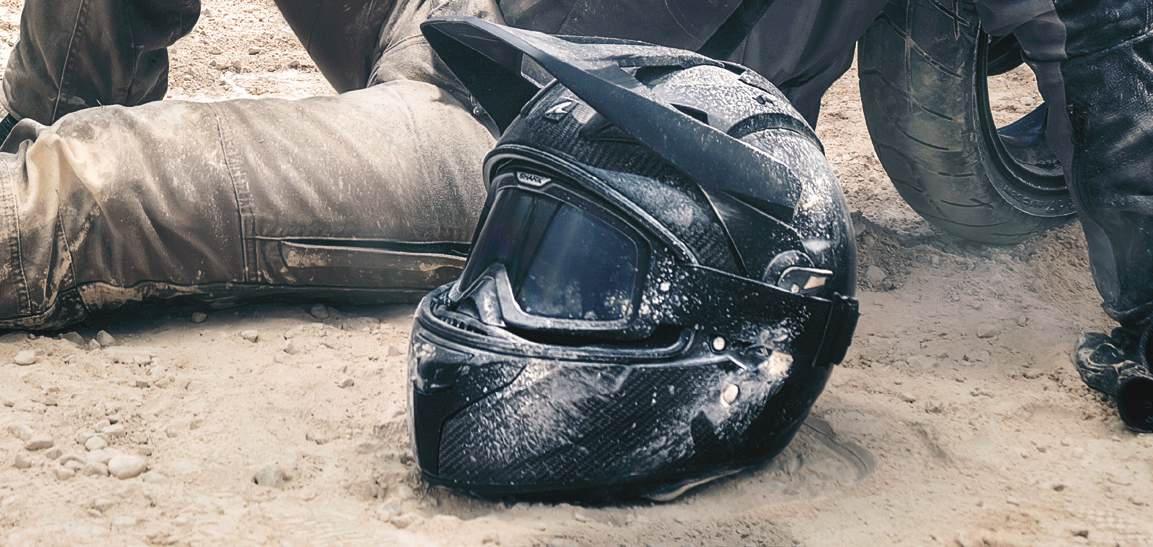






A fullface helmet? An offroad helmet? The Explore-R is both at once. A helmet with a carbon look able to face all terrains. It offers the same panoramic vision field as the Vision-R in full face configuration, very light weight and a well-designed ventilation system for extreme conditions.



